Framing the Revolution:

Contemporary Chinese Photographs from the Jack and Susy Wadsworth Collection




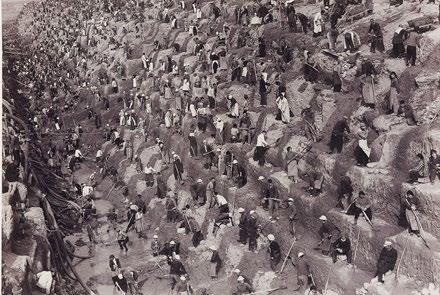
Special Exhibition Gallery Guide
January-August 2023
Jordan Schnitzer Museum of Art, University of Oregon
Images © the Artists
Text © Jordan Schnitzer Museum of Art, University of Oregon, 2023.
All rights reserved.
No portion of this publication may be reproduced without the written permission of the publisher.
Framing the Revolution: Contemporary Chinese Photographs from the Jack and Susy Wadsworth Collection
This exhibition features more than 50 politically charged works produced by seven artists between 1958 and 2006. Together, they reflect upon modern Chinese history, examining events such as the Red Army’s Long March (1934-35), the Great Proletarian Cultural Revolution (1966-76), and other moments of tremendous change and social upheaval.
This abbreviated survey of mid-20th to early 21st-century Chinese photography begins with propaganda images by Wang Shilong produced before, during, and after the Cultural Revolution. It continues with journalistic images by Liu Heung Shing documenting the idealistic young artists behind the 1979 Stars Art Exhibition. It also features two series focused on historic political sites: Shao Yinong and Muchen’s monumental images of empty assembly halls where important meetings took place between 1929 and the establishment of the People’s Republic of China in 1949, and a series of images and video by Qin Ga that retrace the harrowing 5,600-mile Long March. The exhibition concludes with the infamous photograph of Xiao Lu’s performance at the opening of the 1989 China/Avant-Garde Exhibition and powerful works by Sheng Qi that critically examine the legacy of the Communist Party.
In 1987, Jack and Susy Wadsworth moved to Tokyo, where they amassed a collection over 150 important postwar Japanese prints that they donated to the JSMA in 2012 (celebrated in our 2015 Expanding Frontiers exhibition and catalogue). In 1991, they relocated to Hong Kong, which they used as a base for broader explorations of China’s burgeoning art scene, establishing
contacts with cutting-edge artists, critics, and galleries and beginning to collect contemporary Chinese photographs. After they returned to the U.S. in 2001, their Chinese contemporary holdings grew to over 190 works by 16 artists. In 2018, they began donating these works to the museum, greatly expanding the scope of Chinese art available to UO faculty, students, and visitors.
Framing the Revolution is the first major exhibition drawn from Jack and Susy Wadsworth’s contemporary Chinese collection, with shows focusing on other themes planned for the future. We are deeply indebted to the collectors for these vibrant, provocative works and for their ongoing support of our exhibition, teaching, and research missions.
Framing the Revolution: Contemporary Chinese Photographs from the Jack and Susy Wadsworth Collection was curated by Anne Rose Kitagawa, Chief Curator of Collections and Asian Art and Director of Academic Programs. The JSMA extends profound thanks to collectors Jack and Susy Wadsworth for their extremely generous support, and also to Johnson Chang (HanArt TZ, Hong Kong), Jane DeBevoise (Asia Art Archive in Hong Kong and New York), and University of Oregon faculty members Ina Asim (History), Roy Chan (East Asian Languages and Literatures), Chiara Gasparini (History of Art and Architecture), and Bryna Goodman (History) for their expertise, encouragement, and collaboration. This exhibition and its related programs and (forthcoming) publication were made possible with generous support from the WLS Spencer Foundation, the Coeta and Donald Barker Changing Exhibitions Endowment, and JSMA members.
SHENG Qi 盛奇 (Chinese, born 1965)
My Left Hand - Red Army Mao (我的左手 - 毛主席 Wo de zuoshou - Mao

zhuxí), 2004
Color photograph
Gift of the Jack and Susy Wadsworth Collection of Contemporary Chinese Photographs, 2018:28.12
“We grew up in a propaganda environment. Basically, we did not know about anything outside of China. Actually, we were born red and we grew up red. We did not know any other colors. This means that at 24 years old, I did not know anything about other colors…”
WANG Shilong 王世龙 (1930-2013)
Born in Henan province, Wang Shilong worked as an oil painter and photographer in the Propaganda Department of the People’s Liberation Army from 1948 through 1950. He then traveled the country as a photojournalist documenting the political, social, and economic transformation of China from the early days of the People’s Republic (established 1949), through the Great Leap Forward (1958-61), the Great Proletarian Cultural Revolution (1966-76), the end of the era of Mao Zedong (1893-1976), and beyond.
Though he is categorized as a journalist, W ang Shilong’s pictures function as propaganda – the photographic equivalent of the inspirational posters, prints, and paintings produced to serve the ideological goals of the Chinese Communist Party (CCP). His beautifully composed black-and-white images feature inspiring political leaders, rallies, and performances, bumper crops, industrial advancements, and grandiose landscapes re-shaped through collective toil, and were intended to instill faith, fortitude, and a palpable sense of optimism.
WANG Shilong 王世龙 (Chinese, 1930-2013)
Mao Zedong Visiting the Countryside, Qiliying, 1958
Black-and-white photograph, printed later
Gift of the Jack and Susy Wadsworth Collection of Contemporary Chinese Photographs, 2018:38.4b

WANG Shilong 王世龙 (Chinese, 1930-2013)
Before the Meeting, Yunyang County, 1989

Black-and-white photograph, printed later
Gift of the Jack and Susy Wadsworth Collection of Contemporary Chinese Photographs, 2018:38.4h
WANG Shilong 王世龙 (Chinese, 1930-2013)
Studying ‘Mao Zedong Thought’, Jiyuan, 1975
Black-and-white photograph, printed later
Gift of the Jack and Susy Wadsworth Collection of Contemporary Chinese Photographs, 2018:38.4a

WANG Shilong 王世龙 (Chinese, 1930-2013)
The Village Meeting, 1991 Black-and-white photograph, printed later Gift of the Jack and Susy Wadsworth Collection of Contemporary Chinese Photographs, 2018:38.4i
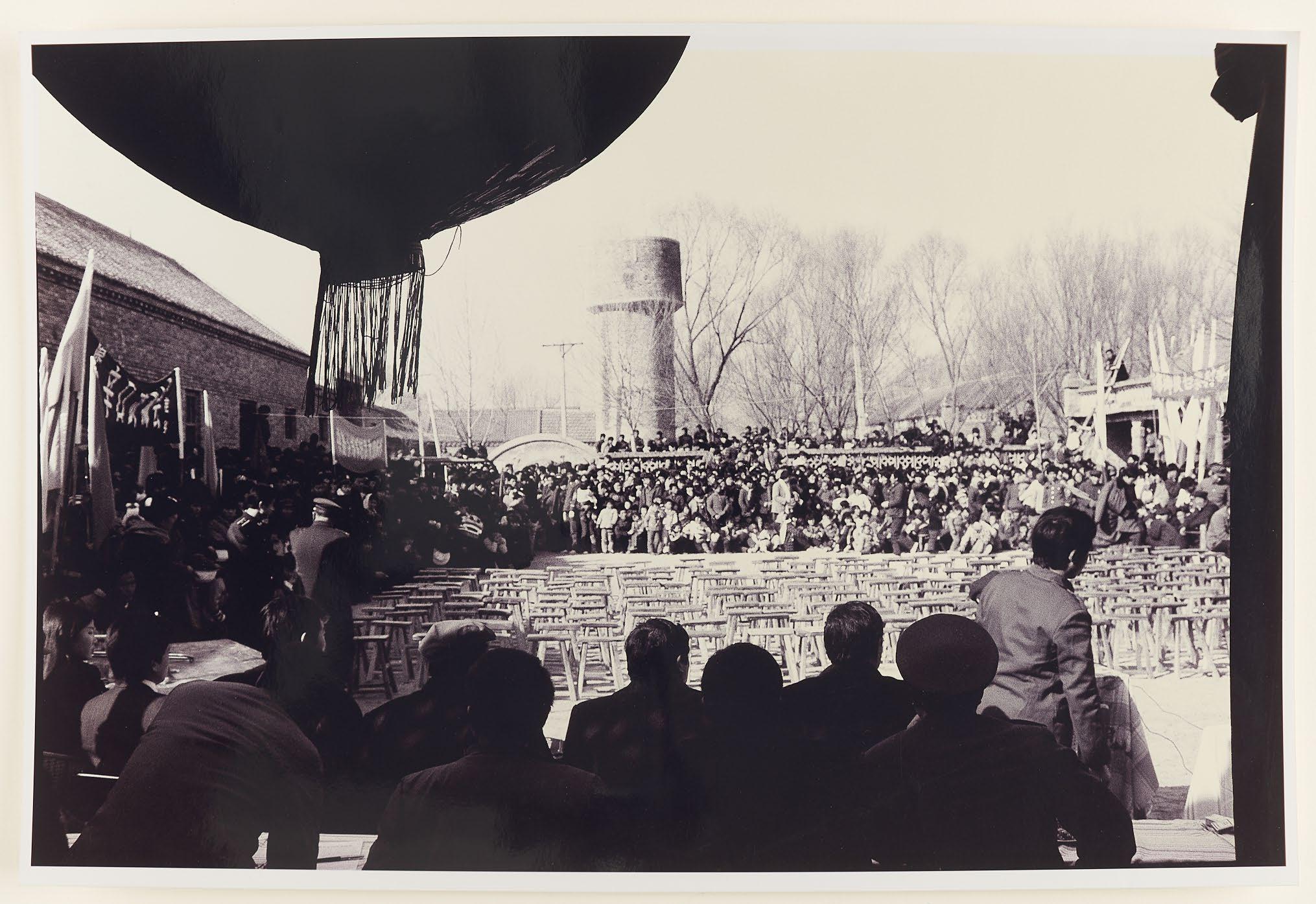
WANG Shilong 王世龙 (Chinese, 1930-2013)
Blocking the Hidden Stream, Huixian County, 1974 Black-and-white photograph, printed later Gift of the Jack and Susy Wadsworth Collection of Contemporary Chinese Photographs, 2018:38.4f

WANG Shilong 王世龙 (Chinese, 1930-2013)
Red Flag Canal, Lin Xian County, 1962
Black-and-white photograph, printed later
Gift of the Jack and Susy Wadsworth Collection of Contemporary Chinese Photographs, 2018:38.4c

WANG Shilong 王世龙 (Chinese, 1930-2013)
Reforming the Mountain, Xin Xiang, 1974 Black-and-white photograph, printed later Gift of the Jack and Susy Wadsworth Collection of Contemporary Chinese Photographs, 2018:38.4e

WANG Shilong 王世龙 (Chinese, 1930-2013)
Reclaiming Land at Tai Hang Mountain, Hui Xian County, 1974 Black-and-white photograph, printed later Gift of the Jack and Susy Wadsworth Collection of Contemporary Chinese Photographs, 2018:38.4g
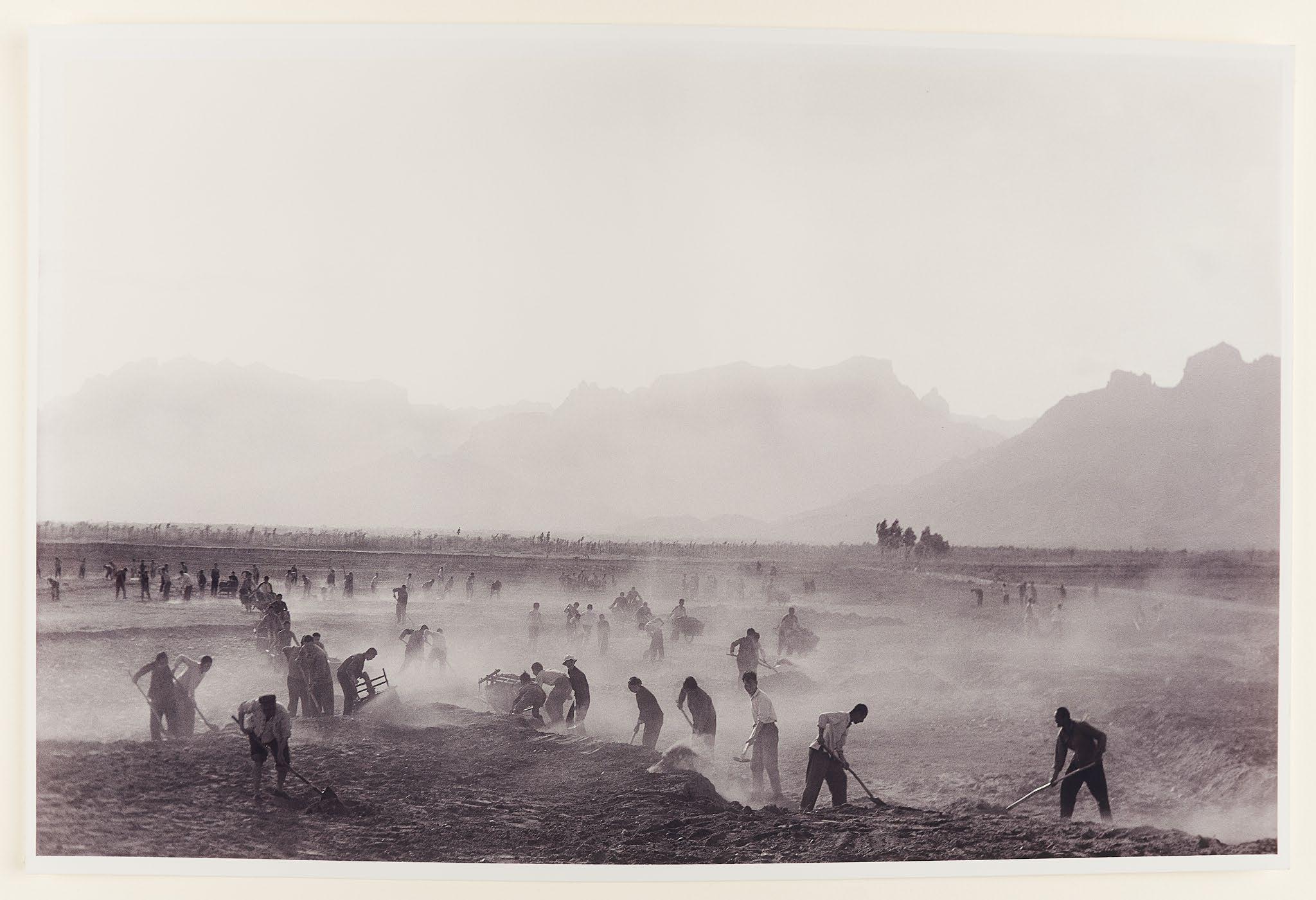
WANG Shilong 王世龙 (Chinese, 1930-2013)
Terraces at Wang Wu Mountain, Jiyuan County, 1966

Black-and-white photograph, printed later
Gift of the Jack and Susy Wadsworth Collection of Contemporary Chinese Photographs, 2018:38.4d
LIU Heung Shing 劉香成 (born 1951)
Born in Hong Kong then still under British rule, Liu Heung Shing spent ten years in Fuzhou, Fujian province, before returning to Hong Kong for high school. He then moved to New York to attend Hunter College, where he studied with Life magazine photographer Gjon Mili (1904-1984) and graduated with a degree in political science and journalism. In 1976, Liu was hired by Time magazine and sent to China. Later, he worked as a foreign correspondent and photojournalist for the Associated Press, covering stories in India, South Korea, the Sovi et Union, and the U.S., as well as China. A Pulitzer Prize winner and founder and director of the Shanghai Center of Photography (SCôP), Liu is best known for documenting the collapse of the Soviet Union, the opening of China during the early reform era beginning in 1978, and the suppression of student demonstrators in Tiananmen Square in June 1989. He is the author and editor of numerous books including China After Mao: “Seek Truth from Facts” (1983), USSR: The Collapse of an Empire (1992), China: Portrait of a Country (2008), Shanghai, A History in Photographs 1842 to Today (2010), China in Revolution: The Road to 1911 (2013), and Liu Heung Shing: A Life in a Sea of Red (2019).
When Liu Heung Shing arrived in in China in 1978, he was struck by the new sense of openness that prevailed after the death of Mao Zedong (1893-1976). For one year, people felt free to post political comments and grievances on the Democracy Wall (Minzhu qiang) on Xidan Street in Beijing’s Xicheng District. The images featured here document the Stars Art Group (Xingxing huahui), a collective of non-professional avant-garde artists who came together in 1979 with a shared interest in freedom of expression. Some artists are shown in their home studios along
with the idealistic young writers who published the underground literary journal Today (Jintian). The rest of these photos focus on the first Stars Art Exhibition (Xingxing meizhan), for which the artists did not secure official approval, but instead defiantly installed their art on the fence in front of the China Art Gallery in Beijing’s Beihai Park. When their unsanctioned display was shut down by the authorities, the Stars artists staged a protest that succeeded in persuading officials to allow the show to reopen. It was attended by approximately 200,000 visitors. In the following year, the Stars organized a second show, but ultimately they had to disband due to political pressures that caused various members to go into exile.
LIU Heung Shing 劉香成 (Chinese-born American, born 1951)
Artist MA Desheng (馬德升) at Home Studio, 1978

Black-and-white photograph, ed. 2/16, printed later
Gift of the Jack and Susy Wadsworth Collection of Contemporary Chinese Photographs, 2019:31.1
LIU Heung Shing 劉香成 (Chinese-born American, born 1951)
Artist MA Desheng (馬德升) at Home Studio, 1978
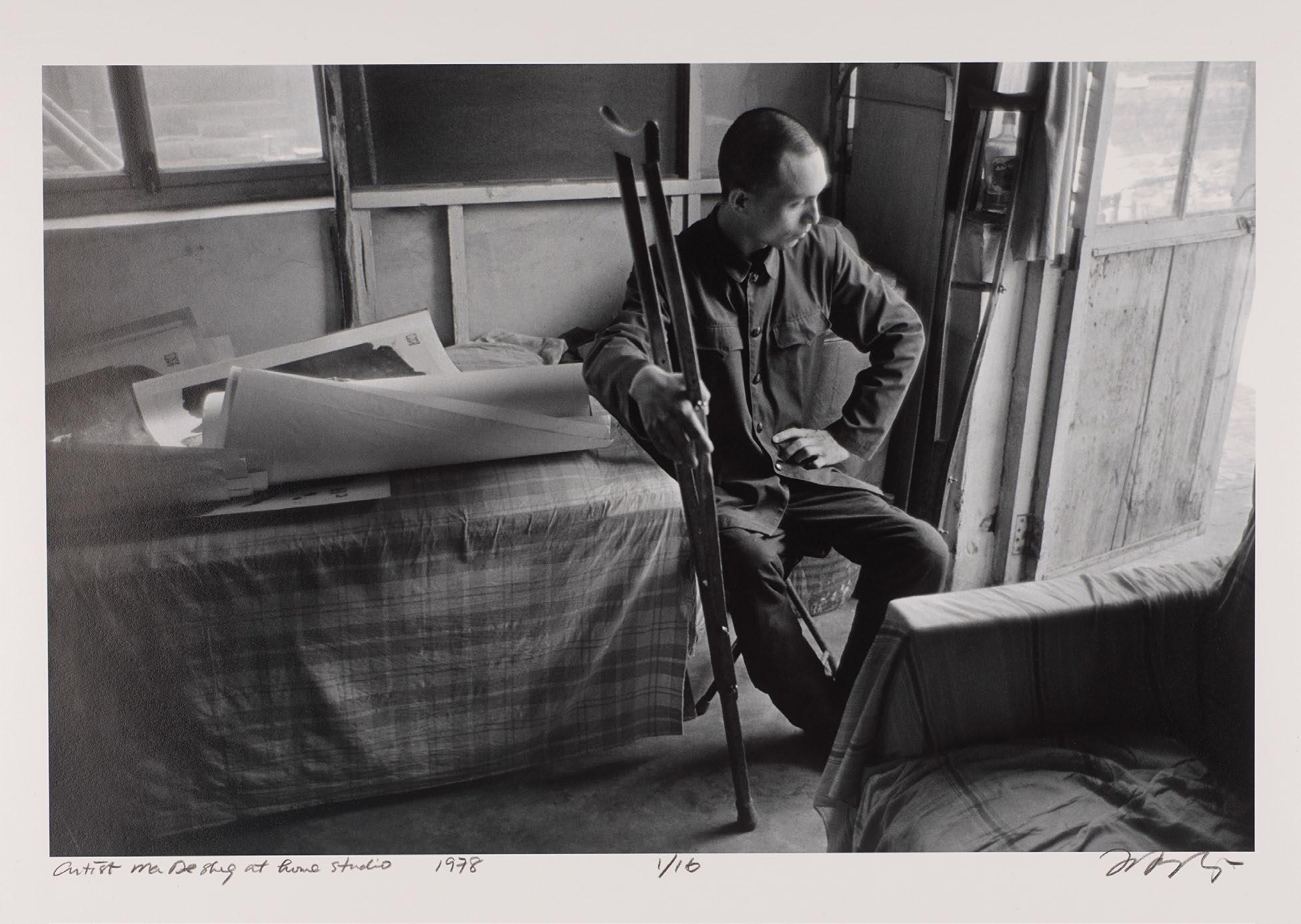
Black-and-white photograph, ed. 1/16, printed later
Gift of the Jack and Susy Wadsworth Collection of Contemporary Chinese Photographs, 2019:31.2
LIU Heung Shing 劉香成 (Chinese-born American, born 1951)
Artist WANG Keping (王克平), 1978
Black-and-white photograph, ed. 3/16, printed later
Gift of the Jack and Susy Wadsworth Collection of Contemporary Chinese Photographs, 2019:31.3
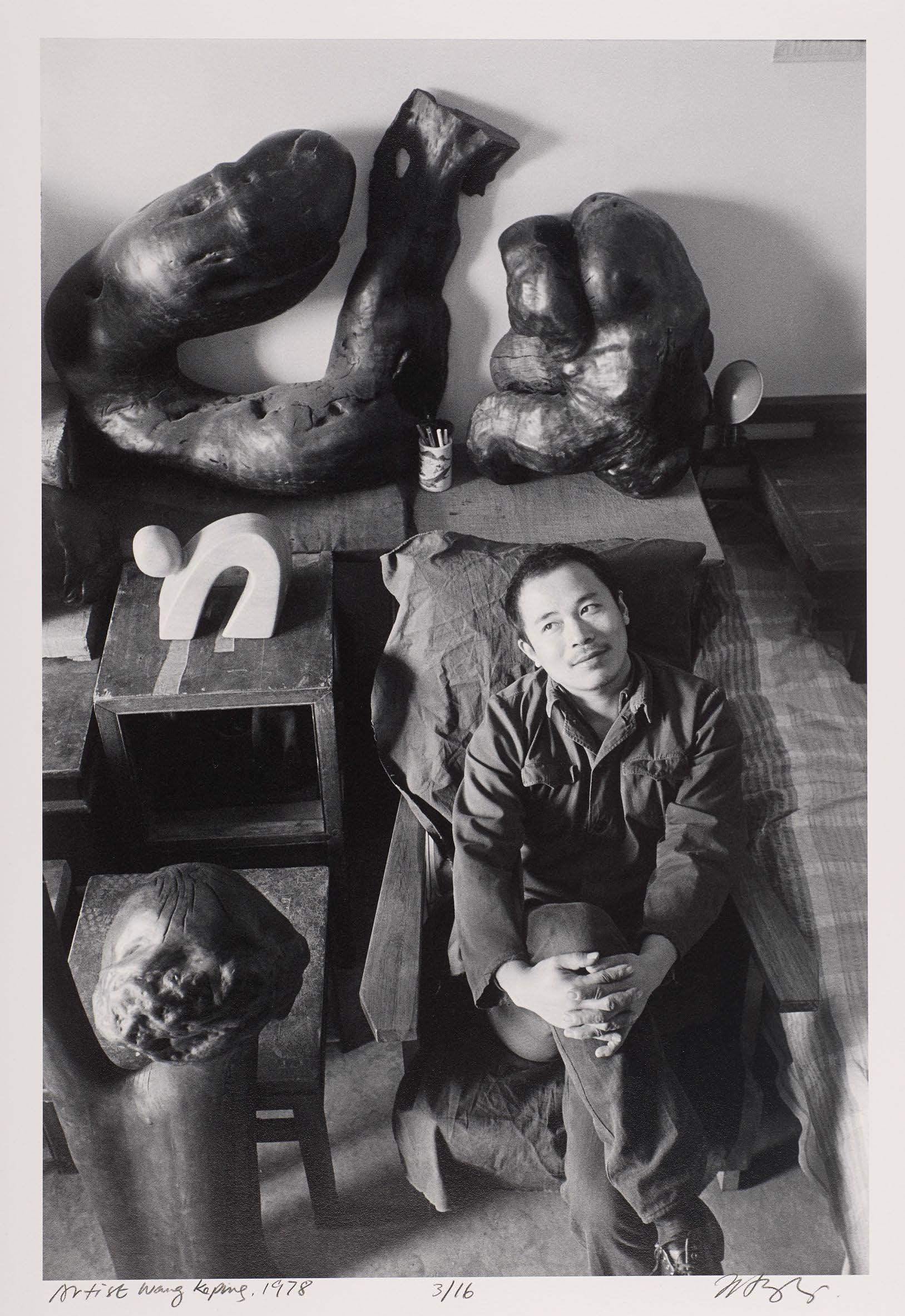
LIU Heung Shing 劉香成 (Chinese-born American, born 1951)
Binding Underground Journal Today (今天 Jintian), Beijing, 1979
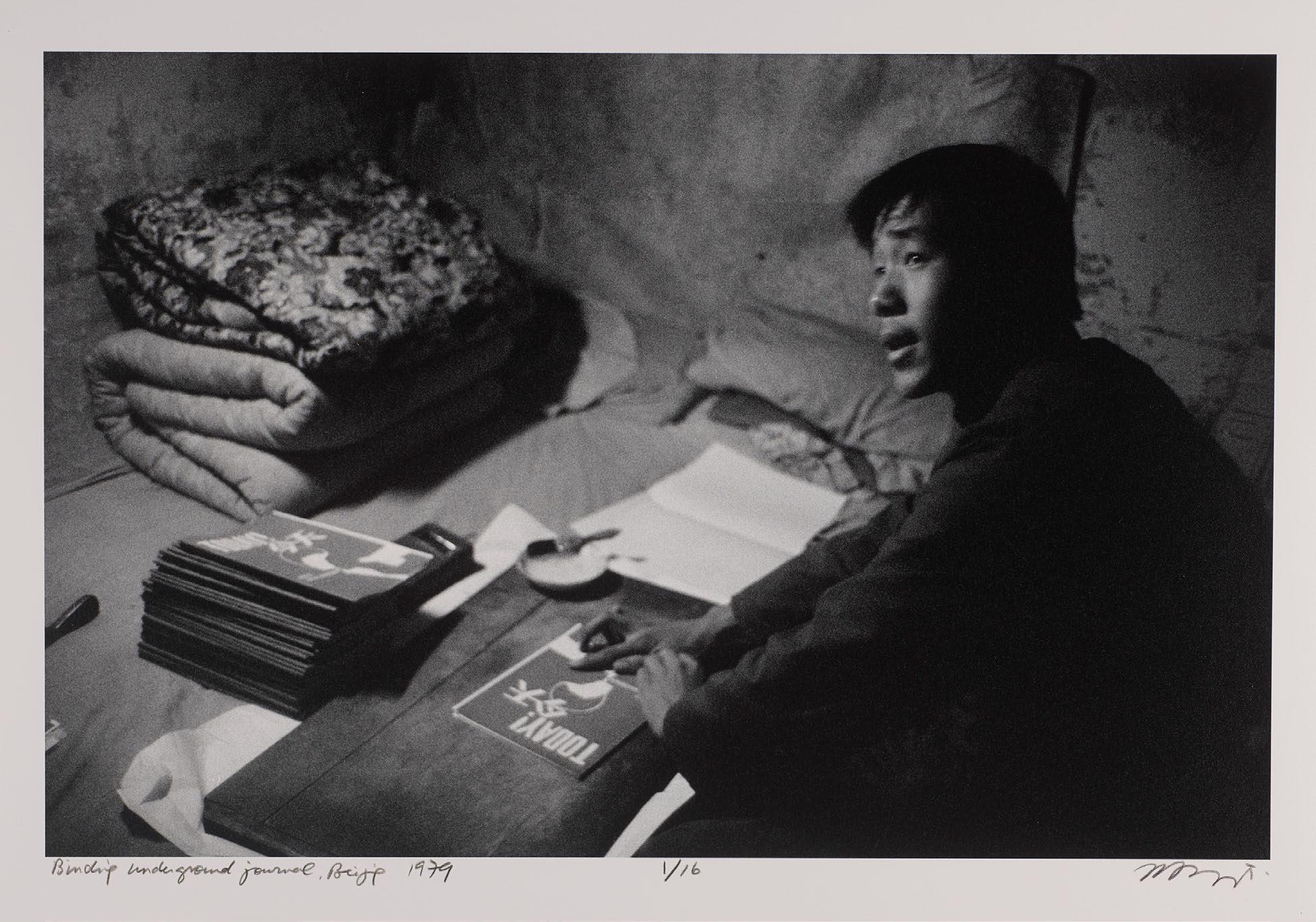
Black-and-white photograph, ed. 1/16, printed later
Gift of the Jack and Susy Wadsworth Collection of Contemporary Chinese Photographs, 2019:31.9
LIU Heung Shing 劉香成 (Chinese-born American, born 1951)
Members of Today (今天 Jintian) Group, Beijing, 1979 Black-and-white photograph, ed. 1/16, printed later Gift of the Jack and Susy Wadsworth Collection of Contemporary Chinese Photographs, 2019:31.10

LIU Heung Shing 劉香成 (Chinese-born American, born 1951)
Democracy Wall, Beijing, 1979

Black-and-white photograph, ed. 1/16, printed later
Gift of the Jack and Susy Wadsworth Collection of Contemporary Chinese
Photographs, 2019:31.11
LIU Heung Shing 劉香成 (Chinese-born American, born 1951)
Artist (YIN Guangzhong 尹光中) by Democracy Wall, Beijing, 1979

Black-and-white photograph, ed. 2/16, printed later
Gift of the Jack and Susy Wadsworth Collection of Contemporary Chinese Photographs, 2019:31.7
LIU Heung Shing 劉香成 (Chinese-born American, born 1951)
Poet Mang Ke (芒克), Yuanmingyuan, Beijing, 1979
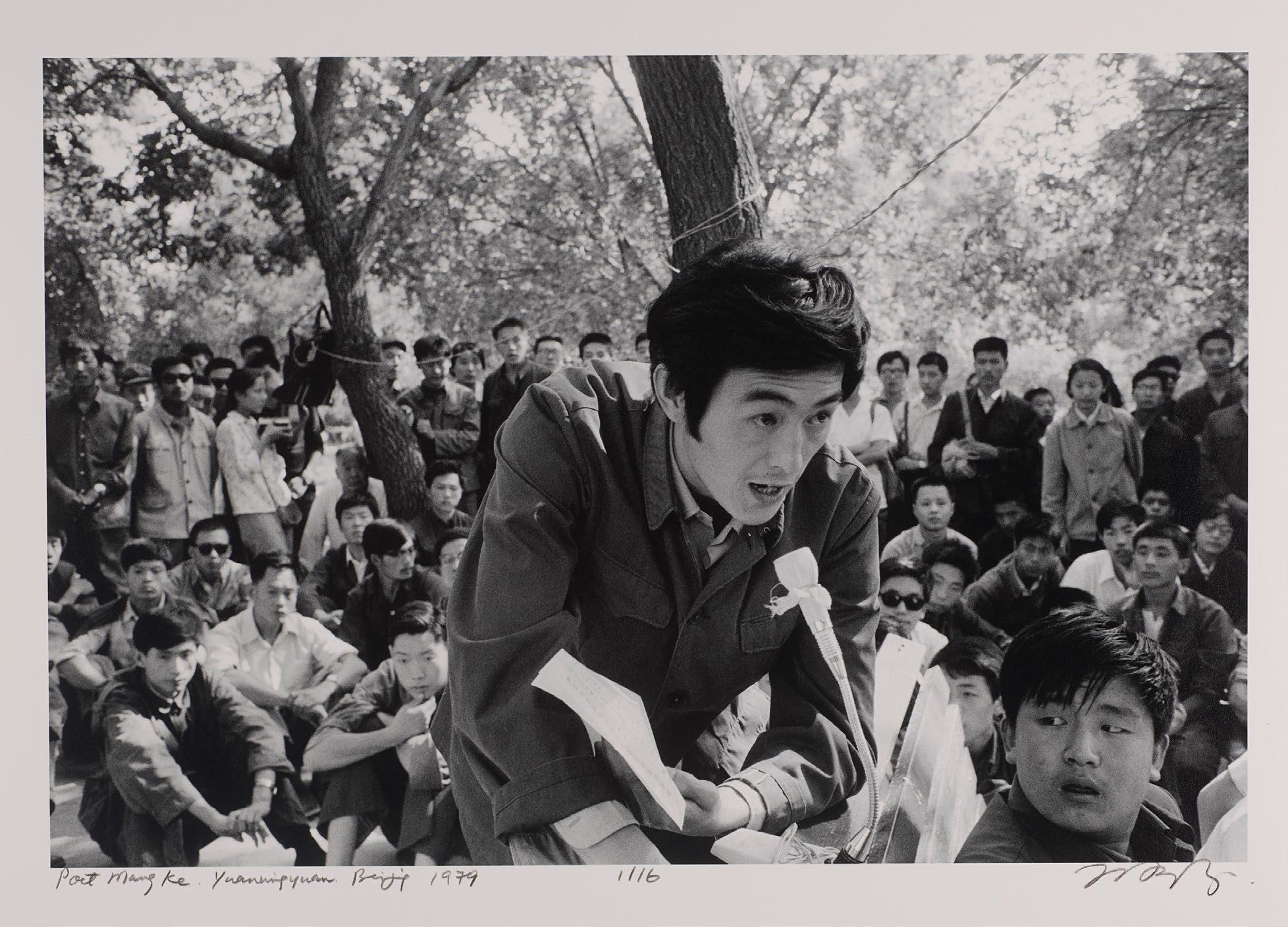
Black-and-white photograph, ed. 1/16, printed later
Gift of the Jack and Susy Wadsworth Collection of Contemporary Chinese Photographs, 2019:31.8
LIU Heung Shing 劉香成 (Chinese-born American, born 1951)
Artist MA Desheng (馬德升) at Beijing City Hall, 1979

Black-and-white photograph, ed. 3/16, printed later
Gift of the Jack and Susy Wadsworth Collection of Contemporary Chinese Photographs, 2019:31.5
LIU Heung Shing 劉香成 (Chinese-born American, born 1951)
Artist and Protesters in Beijing, 1979 Black-and-white photograph, ed. 1/16, printed later Gift of the Jack and Susy Wadsworth Collection of Contemporary Chinese Photographs, 2019:31.4
Translation of signs: March to protect the constitution and Arresting the “Stars” Art Group, (equals) insulting the constitution

LIU Heung Shing 劉香成 (Chinese-born American, born 1951)
Artist WANG Keping (王克平) in Beijing, 1979

Black-and-white photograph, ed. 8/16, printed later
Gift of the Jack and Susy Wadsworth Collection of Contemporary Chinese
Photographs, 2019:31.6
LIU Heung Shing
劉香成
(Chinese-born American, born 1951)
Artists and Students at a Protest March in Beijing, 1979
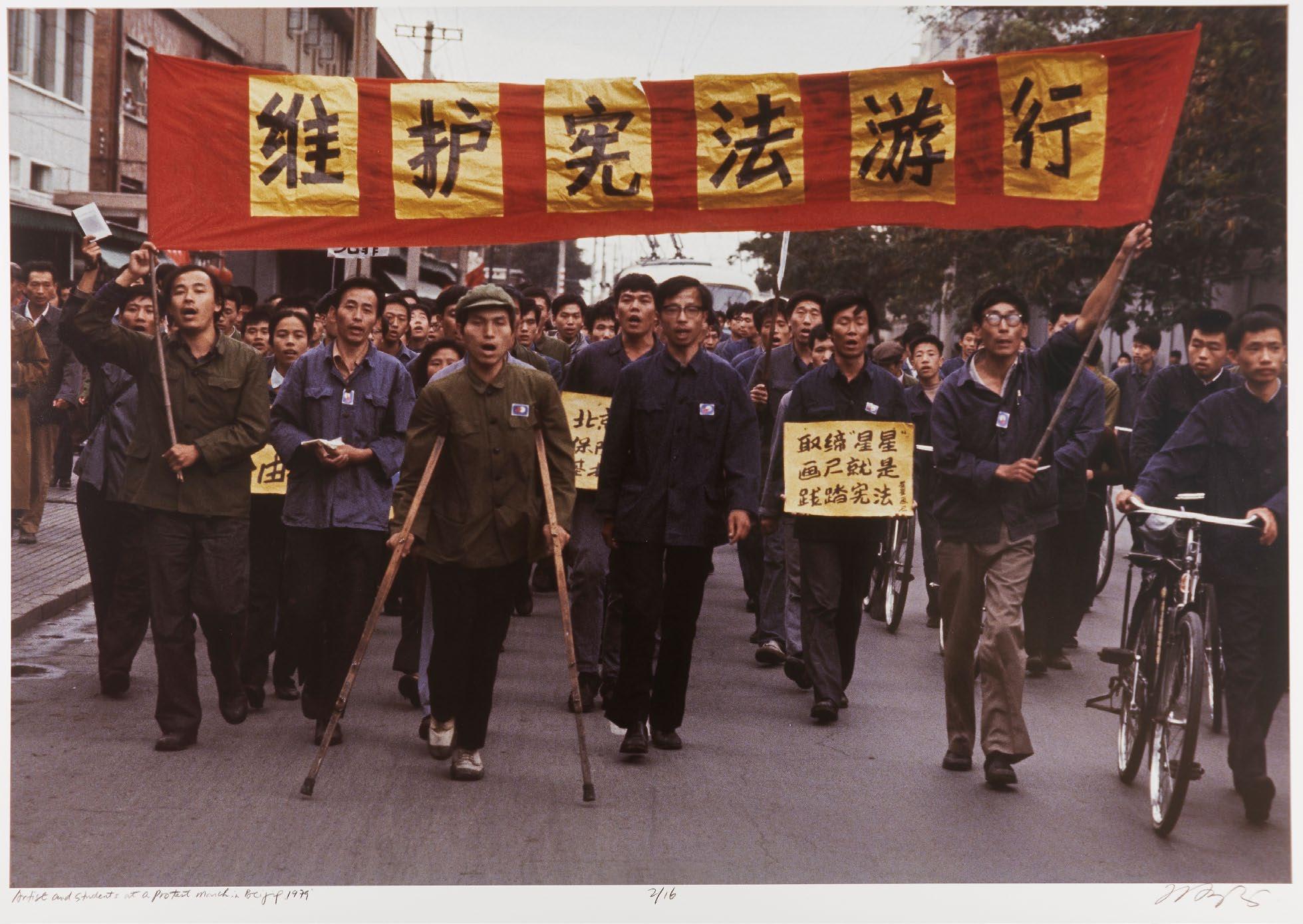
Color photograph, edition 2/16, printed later
Gift of the Jack and Susy Wadsworth Collection of Contemporary Chinese Photographs, 2019:31.12
Translation of large sign above: March to protect the constitution
Translation of smaller sign: [If you] Arrest the “Stars” Art Group, [you] insult the constitution
QIN Ga 琴嘎 (born 1971)
Born in Bayannur, Inner Mongolia, Qin Ga also produces art under his Mongolian name, Chyanga. In high school, he excelled at drawing. When he learned of an opportunity to further his artistic studies in Beijing he jumped at the chance, ultimately earning a BFA (1997) and an MFA (2004) in Sculpture from Beijing’s Central Academy of Fine Arts.
While still a student, Qin Ga participated in the initial phase of The Long March Project, a contemporary art collective founded by Lu Jie (卢杰) and Qiu Zhijie (邱志杰 ) that began with “ The Long March Project— A Walking Visual Display,” which sought to explore revolutionary memory by retracing the Red Army’s 1934-35 Long March with various planned performances and displays at sites along the historic route. Qin Ga did not physically accompany the travelers. Instead, he maintained contac t with them, marking their progress by tattooing the name of each successive destination on the map of China he had inscribed on his back for the purpose, and documenting their journey through a series of photos and video to create his Miniature Long March.
During that first phase of The Long March Project (from June-August 2002), the participants only retraced the part of the Red Army’s historic route from Beijing to the Luding Bridge in Sichuan. Three years later Qin Ga decided to complete the journey.
On the following 7 pages:
QIN Ga 琴嘎 (Chinese, born 1971)
Miniature Long March Nos. 1-14 (微型长征第一至十四号
Weixing changzheng di yi zhi shisi hao), 2002
Set of 14 color photographs, edition 4/5
Gift of the Jack and Susy Wadsworth Collection of Contemporary Chinese Photographs, 2018:28.2a-n
Miniature Long March Site 1, Beijing (北京 Beijing), from the series Miniature Long March
Nos. 1-14 (微型长征第一至十四号
Weixing changzheng di yi zhi shisi hao), 2002
Miniature Long March Site 2, Ruijin, Jiangxi province (瑞金, 江西省 Ruijin, Jiangxi sheng), from the series Miniature Long March Nos. 1-14 (微型长征
第一至十四号
Weixing
changzheng di yi zhi shisi hao), 2002


Miniature Long March Site 3, Jinggangshan Mountain, Jiangxi province (井冈山, 江西省 Jinggangshan, Jiangxi sheng), from the series Miniature Long
March Nos. 1-14 (微型长征第一至
十四号 Weixing changzheng di yi zhi shisi hao), 2002
Miniature Long March Site 4, On the Road in Guangxi Autonomous Region (广西壮族
自治区 Guangxi zhuangzu zizhiqu), from the series

Miniature Long March Nos. 1-14 (微型长征第一至十四号 Weixing changzheng di yi zhi shisi hao), 2002

Miniature Long March Site 5, Kunming, Yunnan province (昆
明市, 云南省 Kunming shi, Yunnan sheng), from the series


Miniature Long March Nos. 1-14
(
微型长征第一至十四号 Weixing
changzheng di yi zhi shisi hao), 2002
Miniature Long March Site 6, Lijiang, Yunnan province (丽江
市, 云南省 Lijiang shi, Yunnan sheng), from the series
Miniature Long March Nos. 1-14
(
微型长征第一至十四号 Weixing
changzheng di yi zhi shisi hao), 2002
Miniature Long March Site 7, Lugu Lake, Yunnan-Sichuan province border (泸沽湖, 云南省/ 四川省 Lugu hu, Yunnan sheng/ Sìchuan sheng), from the series Miniature Long March Nos. 1-14 (微型长征第一至十四号 Weixing changzheng di yi zhi shisi hao), 2002
Miniature Long March Site 8, Lugu Lake, Lijiang, YunnanSichuan province (泸沽湖/丽江, 云南省/四川省 Lugu hu, Lijiang, Yunnan sheng/Sichuan sheng), from the series Miniature Long March Nos. 1-14 (微型长征第一至
十四号 Weixing changzheng di yi zhi shisi hao), 2002


Miniature Long March Site 9, Lijiang-Kunming, Yunnan province (丽江/昆明, 云南省 Lijiang/Kunmíng, Yunnan sheng), from the series
Miniature Long March Nos. 1-14 (微型长征第一至十四号 Weixing changzheng di yi zhi shisi hao), 2002
Miniature Long March Site 10, Zunyi, Guizhou province (遵义市 , 贵州省 Zunyi shi, Guizhou sheng), from the series
Miniature Long March Nos. 1-14 (微型长征第一至十四号 Weixing changzheng di yi zhi shisi hao), 2002


Miniature Long March Site 11, Maotai, Guizhou province (茅台
镇, 贵州省 Maotai zhen, Guizhou sheng), from the series
Miniature Long March Nos. 1-14 (
微型长征第一至十四号 Weixing
changzheng di yi zhi shisi hao), 2002
Miniature Long March Site 12, Xichang, Sichuan province (西昌
市, 四川省 Xichang shi, Sichuan sheng), from the series


Miniature Long March Nos. 1-14
(
微型长征第一至十四号 Weixing
changzheng di yi zhi shisi hao), 2002
Miniature Long March Site 13, Moxi, Sichuan province (摩西鎮, 四川省 Moxi zhen, Sìchuan sheng), from the series Miniature Long March Nos. 1-14 (微型长征第一至十四号 Weixing changzheng di yi zhi shisi hao), 2002
Miniature Long March Site 14, Luding Bridge, Sichuan province (泸定桥, 四川省 Luding qiao, Sichuan sheng), from the series Miniature Long March Nos. 1-14 (微型长征第一至十四号 Weixing changzheng di yi zhi shisi hao), 2002
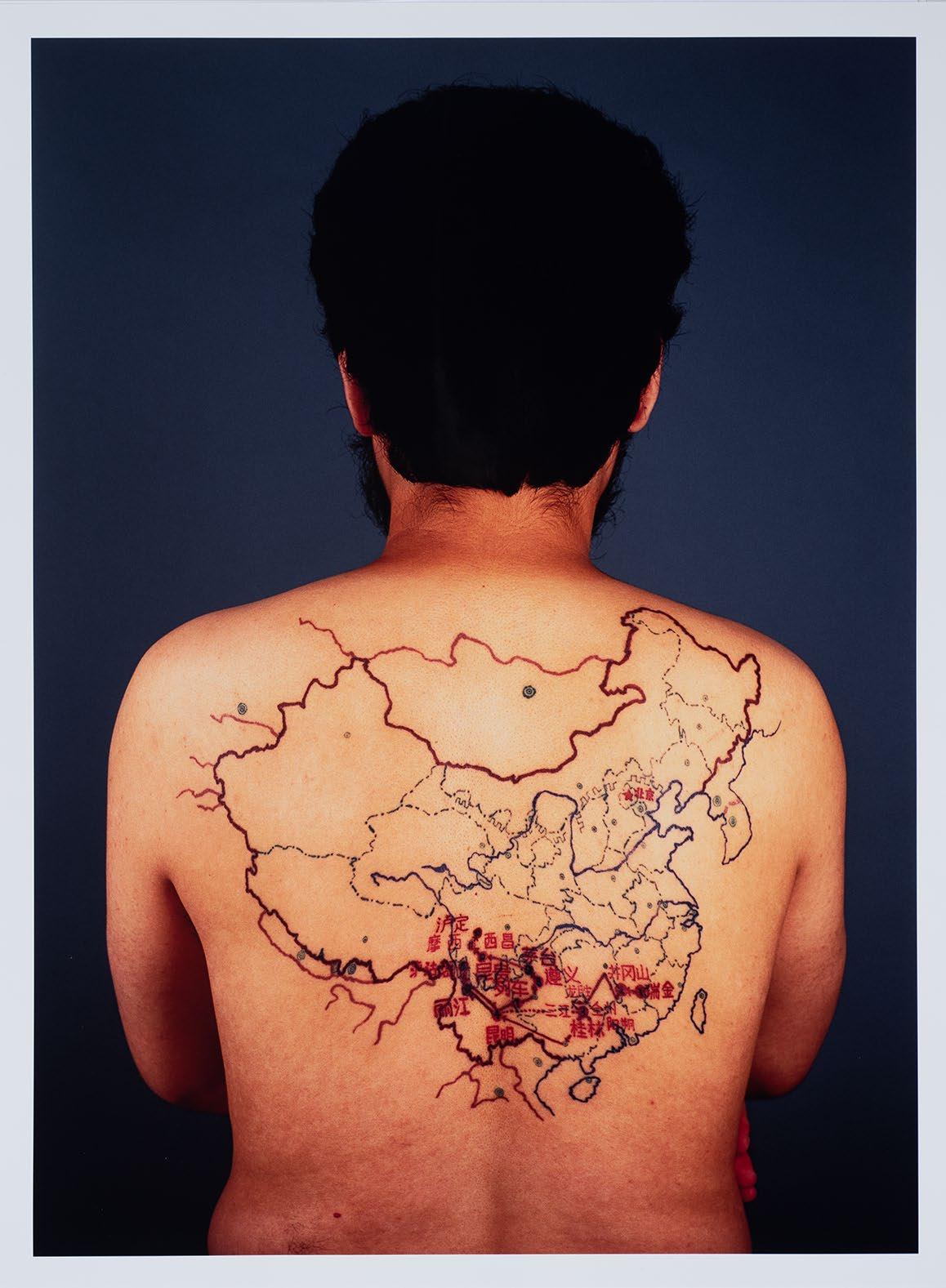
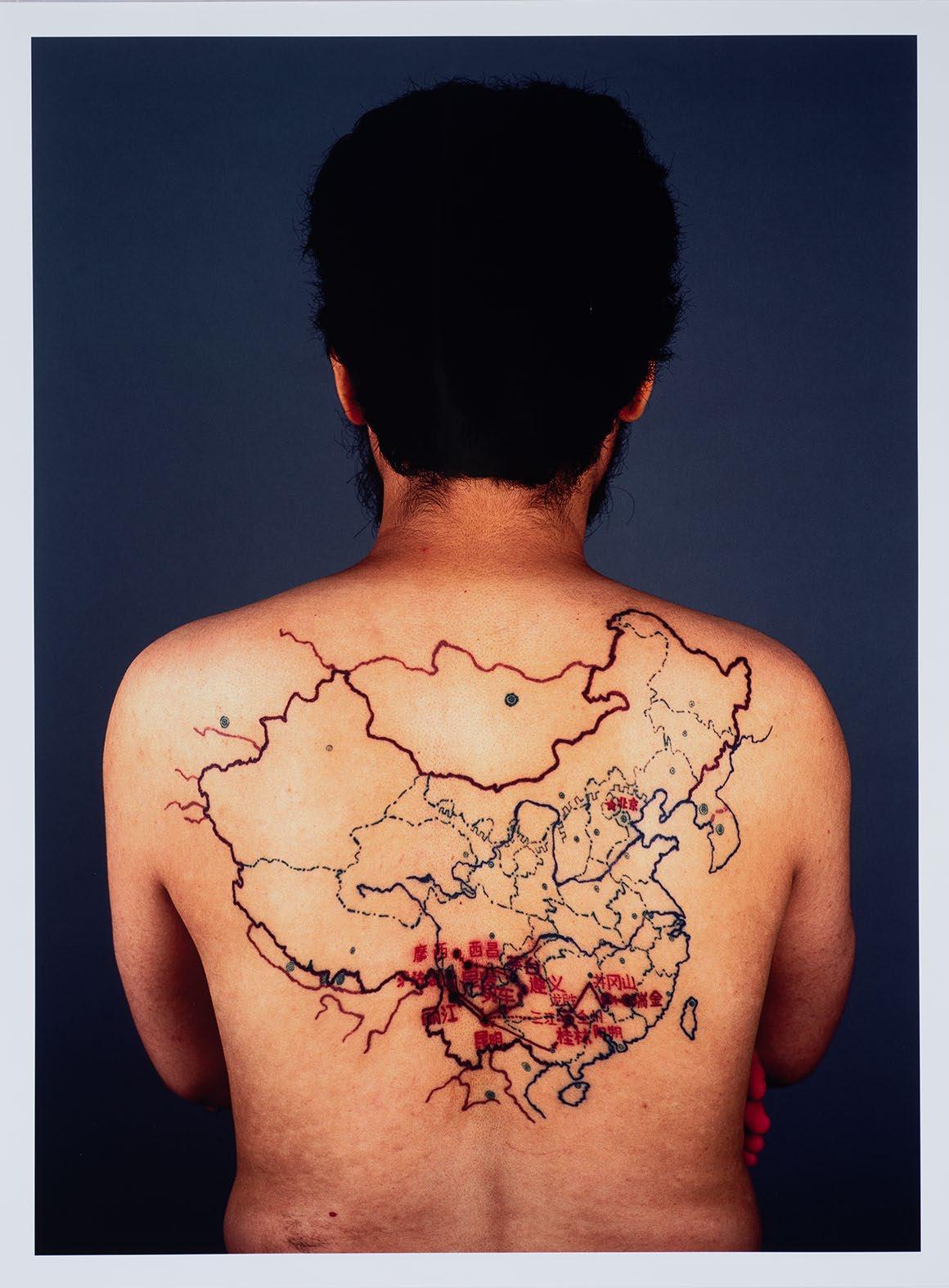
On the following 5 pages:
QIN Ga 琴嘎 (Chinese, born 1971)
Miniature Long March Nos. 15-23 (微型长征第十五至二十三
Weixing changzheng di shiwu zhi ershisan), 2005
Set of nine color photographs, edition 4/5
Gift of the Jack and Susy Wadsworth Collection of Contemporary Chinese Photographs, 2018:28.3a-i
In 2005, Qin Ga completed his Miniature Long March by traveling to nine remaining sites of the Red Army’s Long March from the Luding Bridge in Sichuan (last photo on the right) all the way to Nanniwan in Shanxi province (far left) accompanied by tattoo artist Gao Qiang and photographers Li Ding, Gao Feng, and Mei Er. For this continuation of the Long March Project, they traveled across southwest China tattooing the last nine sites onto Qin Ga’s back and then photographing him in front of the local scenery, creating a sense of the artist as historical witness.
Miniature Long March Site 15, Jiajinshan Snowy Mountain, Sichuan province (夹金山, 四川
省 Jiajinshan, Sichuan sheng), from the series Miniature Long
March Nos. 15-23 (微型长征第十
五至二十三 Weixing changzheng di shiwu zhi ershisan), 2005
Miniature Long March Site 16, Dawei Meeting Bridge, Sichuan province (达维会师桥, 四川省
Dawei huishi qiao, Sichuan sheng), from the series
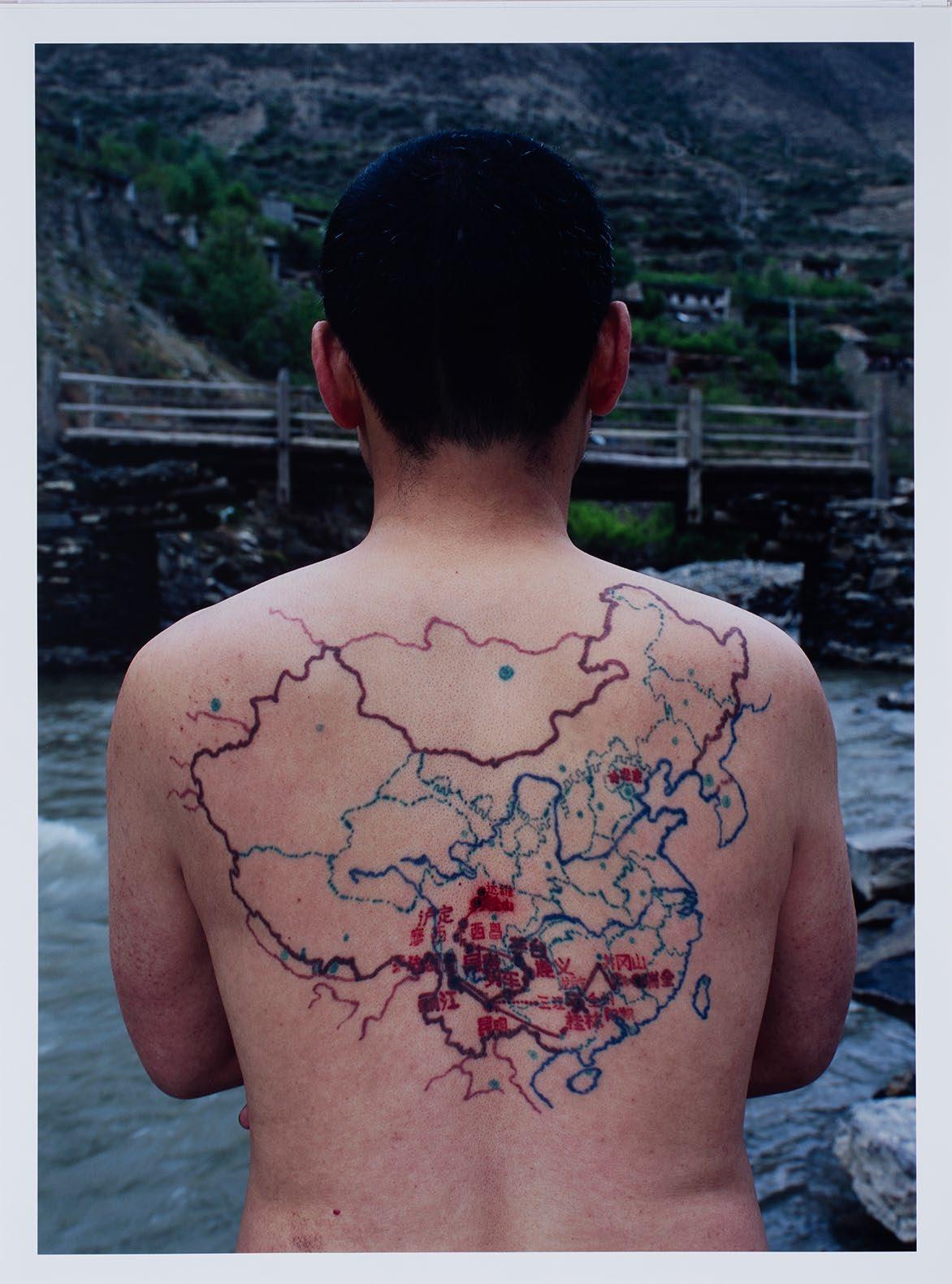
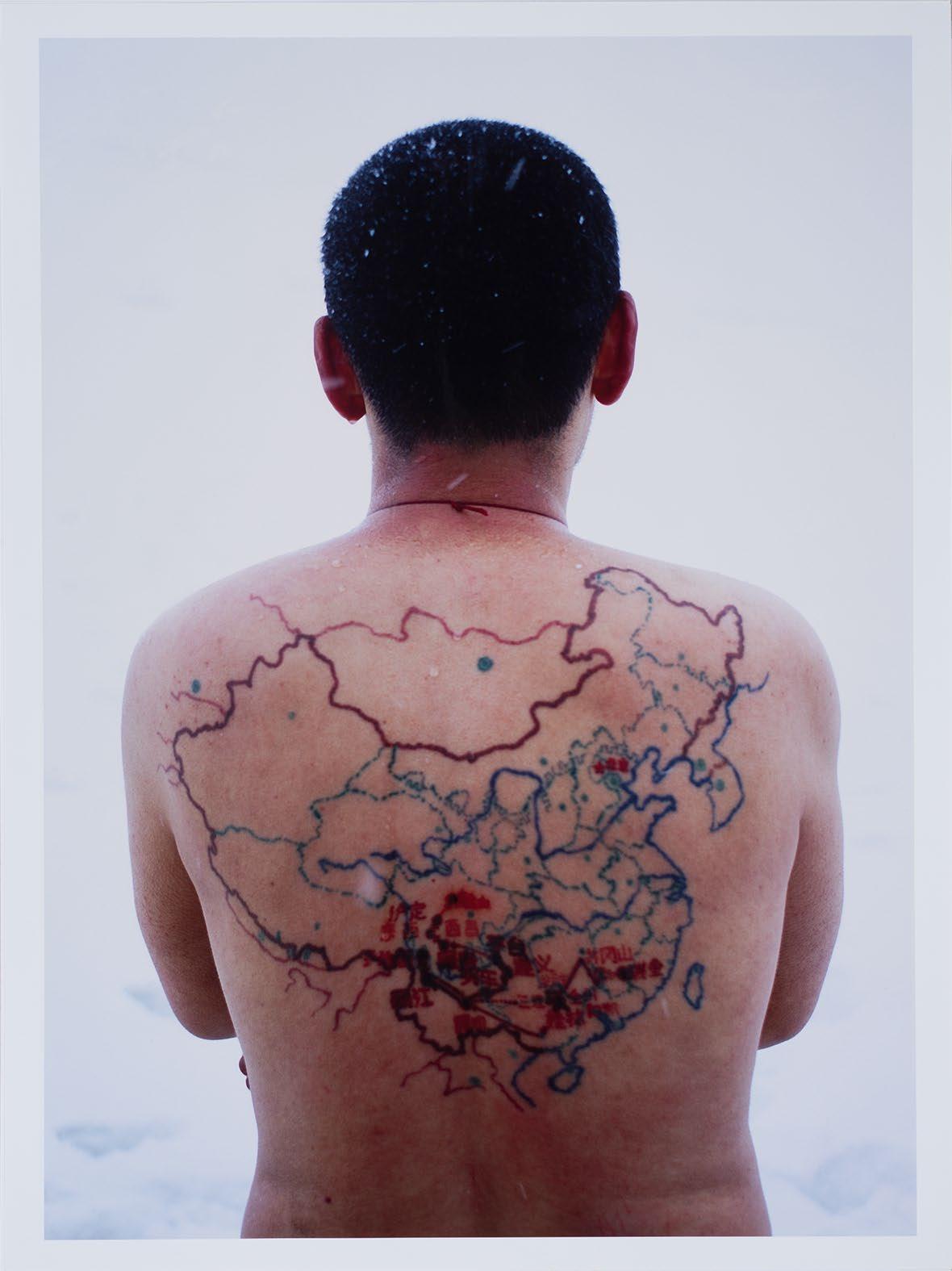
Miniature Long March Nos. 15-23 (微型长征第十五至二十三
Weixing changzheng di shiwu zhi ershisan), 2005
Miniature Long March Site 17, Zhuokeji Fortress of the Tibetan Landlord, Sichuan province (卓克基土司官寨, 四川省
Zhuokeji tusi guan zhai, Sichuan sheng), from the series
Miniature Long March Nos.
15-23 (微型长征第十五至二十三
Weixing changzheng di shiwu
zhi ershisan), 2005
Miniature Long March Site 18, Hongyuan Grasslands, Sichuan province (红原县, 四川省
Hongyuan xian, Sichuan sheng), from the series


Miniature Long March Nos.
15-23 (微型长征第十五至二十三
Weixing changzheng di shiwu
zhi ershisan), 2005
Miniature Long March Site 19, Baxi Former Meeting Hall, Sichuan province (巴西, 四川省
Baxi, Sichuan sheng), from the series Miniature Long March


Nos. 15-23 (微型长征第十五至二
十三 Weixing changzheng di shiwu zhi ershisan), 2005
Miniature Long March Site 20, Huining Meeting Site Entrance, Gansu province (会宁, 甘肃省 Huining, Gansu sheng), from the series Miniature Long March Nos. 15-23 (微型长征第十五至二
十三 Weixing changzheng di shiwu zhi ershisan), 2005
Miniature Long March Site 21, Yan'an Precious Pagoda, Shanxi province (延安宝塔, 陕西
省 Yan'an baota, Shanxi sheng), from the series Miniature Long

March Nos. 15-23 (微型长征第十
五至二十三 Weixing
changzheng di shiwu zhi
ershisan), 2005
Miniature Long March Site 22, Mao Zedong’s Old Residence, Hengshang County, Shanxi province (毛泽东故居, 横山区, 陕
西省 Mao Zedong guju, Hengshan qu, Shanxi sheng), from the series Miniature Long

March Nos. 15-23 (微型长征第十
五至二十三 Weixing
changzheng di shiwu zhi
ershisan), 2005
Miniature Long March Site 23, Nanniwan, Shanxi province (南
泥湾, 陕西省 Nanniwan, Shanxi sheng), from the series

Miniature Long March Nos.
15-23 (微型长征第十五至二十三
Weixing changzheng di shiwu zhi ershisan), 2005
QIN Ga 琴嘎 (Chinese, born 1971)
The Miniature Long March (微型长征 Weixing changzheng), 2002-2005
Single channel video, ed. 6/8 (runtime 40:20)
Gift of the Jack and Susy Wadsworth Collection of Contemporary Chinese Photographs, 2018:28.4
In 2005, Qin Ga completed his Miniature Long March by traveling from the Luding Bridge in Sichuan to Nanniwan in Shanxi accompanied by tattoo artist Gao Qiang and photographers Li Ding, Gao Feng, and Mei Er. This is the video component of that journey, which was as much about the group’s experiences along the way as it was about retracing the steps of history.

Regarding his artistic process, Qin Ga remarked:
“I wouldn’t consider myself a performance artist. I always choose different media to express what I want to express. But regardless of what medium I choose (installation, sculpture, or live art), they all have to do with the body. The way I see this Miniature Long March is just an action. The Long March that happened 70 years ago was a forced action for survival, but the Long March of an artist is not a forced action, it’s an action of my own choice. It’s not for survival, it’s to challenge myself. I hoped to make people think through my personal action. I hope to transform this visual display into the thoughts in their minds…. The pain on my back is a source of imagination of the history and also of the current situation. And the route that the needle took on my back recorded the route that I went on the journey.”*
*from the YouTube video APT5 / Qin Ga discussed his art practice, conducted during the Asia Pacific Triennial of Contemporary Art (APT5) at the Queensland Art Gallery Gallery of Modern Art (QAGOMA) on September 22, 2018.
https://www.youtube.com/watch?v=7NWT7CQpczA
SHAO
Yinong 邵逸农 (born 1961) & MUCHEN 慕辰 (born 1970)
Shao Yinong and Muchen are a couple who work collaboratively and independently on a variety of art projects. Shao was born in Xining, Qinghai province and received his BA in Fine Art from Qinghai Normal University in 1982. He later taught oil painting at the Central Academy of Fine Arts. Muchen (born Zhang Muchen) came from Dandong, Liaoning province and received an MA in Photojournalism from Renmin University of China, Beijing. After marrying in 2000, Shao Yinong and Muchen began working closely together on a series of provocative dream-like photographs that interrogate key moments in modern Chinese history. Their grand Assembly Hall series documents the sites of important political gatherings, but each is shown devoid of people and their voices. The sites’ stillness simultaneously evokes memories of events in the past such as the often violent political struggle sessions, while conveying a poetic sense of emptiness and the desire to confront difficult truths.
Both artists remember the Great Proletarian Cultural Revolution (1966-76), which loomed large during their youth, especially for Shao since a number of his relatives were criticized in such halls:
“… These buildings are a part of a collective memory for most of us…I would track down disused halls. Many were locked up, so I would peek my camera through the old keyhole…and try to take photos. The assembly hall is a space that accumulates the experiences of the Chinese people. So when we (made the) series, we did not
photograph them as architecture, we (thought) of them as portraits…because the destiny of each assembly hall is very different: Some are trashed, some are recovered and rebuilt, (some) are res tored for tourism and education... ” *
When asked about the reception of their works referencing the Cultural Revolution, the artists remarked:
“
It is a collective memory. Therefore, everyone’s memory is different, although it is still shared. Maybe for those born in the 1940s and ‘50s, they have a very strong memory of it. While for those born in the 1980s and ‘90s the experience is different, but it is all part of a collective understanding…. Everybody’s attitude towards this series is so different, bec ause every family’s experience of the assembly hall was varied .”*
*Excerpt from “A Conversation with Shao Yinong and Muchen” conducted by Sam Beard (translated by Tami Xiang) in Guan Kan: Thinking with Contemporary Chinese Art (观看) in July 2019.
https://www.guankanjournal.art/issue-no-2/a-conversation-with-shao-yinong-and-muchen
SHAO Yinong 邵逸农 (Chinese, born 1961) & MUCHEN 慕辰 (Chinese, born 1970)
Maoping (茅坪), from the Assembly Hall Series (大礼堂系列 Da litang

xilie), 2002
Color photograph
Gift of the Jack and Susy Wadsworth Collection of Contemporary Chinese Photographs, 2018:28.10b
Site of a May 1928 regional meeting of the Communist Party.
SHAO Yinong 邵逸农 (Chinese, born 1961) & MUCHEN 慕辰 (Chinese, born 1970)
Gutian (古田), from the Assembly Hall Series (大礼堂系列 Da litang

xilie), 2002
Color photograph
Gift of the Jack and Susy Wadsworth Collection of Contemporary Chinese Photographs, 2018:28.10f
Site of a December 1929 meeting of the Fourth Red Army in which Mao consolidated power.
HE Kongde 何孔德 (1925-2003). Chinese; People’s Republic of China, 1972 Gutian Conference, from the series Selected Works of Art in Commemoration of the 30th Anniversary of Mao Zedong’s Talks at the Yan’an Forum on Literature and Art

Lithographic reproduction of a propaganda painting; ink and color on paper, 12 ¾ x 15 inches. Gift of Irwin Lavenberg, 2020:44.1.3
(on view just outside the main entrance to the exhibition)
SHAO Yinong 邵逸农 (Chinese, born 1961) & MUCHEN 慕辰 (Chinese, born 1970)
Changgang (长冈), from the Assembly Hall Series (大礼堂系列 Da litang xilie), 2002

Color photograph
Gift of the Jack and Susy Wadsworth Collection of Contemporary Chinese Photographs, 2018:28.10a
Site where Mao conducted investigations in 1933.
SHAO Yinong 邵逸农 (Chinese, born 1961) & MUCHEN 慕辰 (Chinese, born 1970)
Qixianzhuang (七贤庄), from the Assembly Hall Series (大礼堂系列 Da litang xilie), 2002

Color photograph
Gift of the Jack and Susy Wadsworth Collection of Contemporary Chinese Photographs, 2018:28.10c
Site of the Communist Party office in Xi’an during the Second Sino-Japanese War (1937-1946).
SHAO Yinong 邵逸农 (Chinese, born 1961) & MUCHEN 慕辰 (Chinese, born 1970)
Yangjialing (杨家岭), from the Assembly Hall Series (大礼堂系列 Da litang xilie), 2006
Color photograph
Gift of the Jack and Susy Wadsworth Collection of Contemporary Chinese Photographs, 2018:28.10e
Hall in which Communist Party meetings took place in Yan’an.

SHAO Yinong 邵逸农 (Chinese, born 1961) & MUCHEN 慕辰 (Chinese, born 1970)
Xibaipo (西柏坡), from the Assembly Hall Series (大礼堂系列 Da litang

xilie), 2005
Color photograph
Gift of the Jack and Susy Wadsworth Collection of Contemporary Chinese Photographs, 2018:28.10d
Communist Party headquarters from 1948-49.
XIAO Lu 肖鲁 (born
1962)
Xiao Lu was born in Hangzhou, Zhejiang province, the eldest child of two Soviet-style oil painters who taught at the Zhejiang Academy from which she received a degree in oil painting in 1988. Because she had been sexually assaulted by a friend of her parents, Xiao was consumed with secret shame and longed to express her rage and sorrow in experimental art. The conservative academy did not approve of anything but an oil painting for her formal graduation piece, but she was permitted to produce one additional work for the same exhibition. Xiao Lu channeled her anguish and confusion into Dialogue, an installation with a red telephone receiver dangling uselessly between images of a man and a woman in separate phone booths. Despite the novelty of expression in the piece, Xiao was dissatisfied because it felt too clean but she did not have the means to disrupt or enliven it. Nevertheless, her installation gained enough notoriety that it was reproduced in an influential art journal and chosen for inclusion in the National Art Gallery’s first avant-garde exhibition in 1989. The fallout after the opening (see adjacent label) rocked the art world and with the escalation of violence against demonstrators at Tiananmen Square a few months later, her unconventional act was ascribed unintended political meaning. This resulted in her having to leave the country.
After eight years in Australia, Xiao Lu returned to China. Following the dissolution of a long, unhappy love affair, she sought to set the record straight concerning her motivations in 1989. Thus, in 2004 she created a new work entitled Dialogue about Dialogue that she performed in front of the recreation of her famous installation. In it, she said:
Fifteen years ago, after I fired those two shots at the China Avant-Garde Art Exhibition at the National Art Museum of China, Beijing, the National Art Museum of China, Beijing was closed.
Fifteen years ago, after the sound of the gunshots, he got involved in the shooting and all that went with it.
Fifteen years ago, when I didn’t know how to explain all that happened after those gunshots, he became the spokesman for the work.
Fifteen years ago, when I was bewildered by the gun, “Love” seemed to have come to me.
Fifteen years ago, I didn’t say a word about this work. For fifteen years,
I firmly believed that the greatest experience brought to me by the “Shooting Incident” was “emotion”.
Today, after fifteen years, I have finally spoken the words that I wanted to say as an artist. Today, after fifteen years, I finally dare to face a place where there is truth. Today, after fifteen years, I present my beloved hair along with the facts to every person present.
and then she cut off locks of her long hair, placed them on 20 copies of the documents she had painstakingly assembled to tell her story, and distributed them to the spectators.
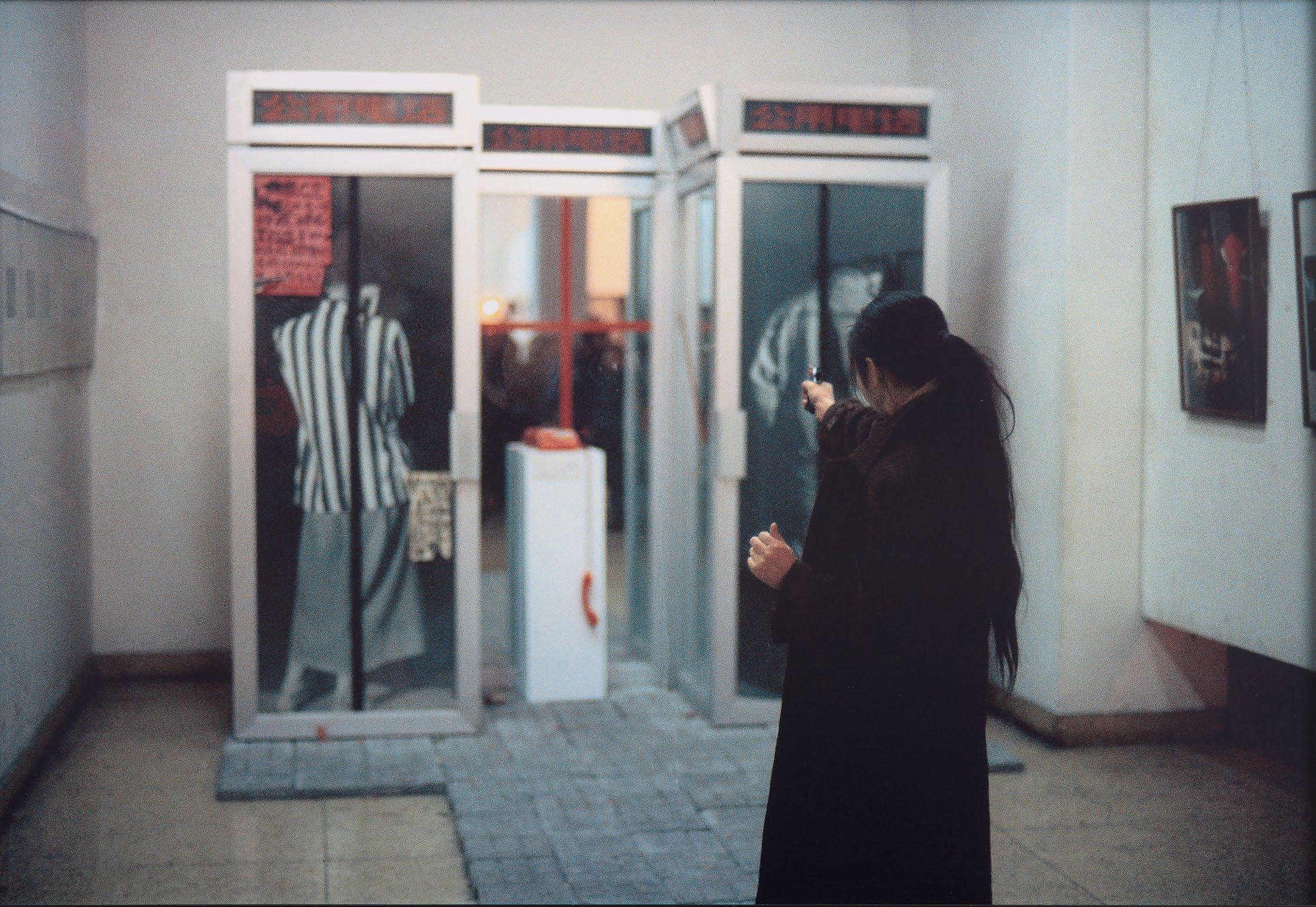
XIAO Lu 肖鲁 (Chinese, born 1962)
Dialogue-Shooting, n.d. (event: 1989)
Color photograph, printed later
Gift of the Jack and Susy Wadsworth Collection of Contemporary Chinese Photographs, 2018:38.2
This dramatic image represents one of the most shocking events in contemporary Chinese art, when Xiao Lu pulled out a gun and fired two shots into her installation entitled Dialogue during the opening of the China/Avant-Garde exhibition on February 5, 1989. This defiant act (compounded by unauthorized performances by other artists) prompted the authorities to temporarily close the exhibition and jail Xiao and her schoolmate Tang Song (唐宋, 1960-2022). Initially excited by the potential emotional release promised by the sound of the shots, Xiao was devastated by the official response and felt incapable of explaining her actions. Instead, Tang, with whom she became romantically involved, fabricated and distributed an explanation of her performance, which was subsequently deemed by critics to have been planned jointly by Xiao and Tang.
Due to the political turbulence of the times, Xiao Lu emigrated to Australia, where she eked out a meager existence and also supported Tang, who followed a few months later. In 1997 they moved back to China. For a total of 15 years, while she struggled to maintain their rocky relationship, she said nothing to contradict the impression that Tang Song had co-created Dialogue-Shooting. However, after he abandoned her at the same moment that she received a request from a gallery asking them both to sign a contract authorizing a recreation of “their” famous piece, Xiao finally broke her long silence and shared the painful trauma of her youth and her subsequent loss of confidence. Many in the world of contemporary Chinese art were unwilling to accept the idea that a female artist could have conceived and executed such a radical performance and refused to revise their attribution of co-authorship, proving that even the avant-garde has its share of backward-thinking, misogynistic critics.
SHENG Qi (盛奇, born 1965)
Sheng Qi was born in Hefei, Anhui province and graduated in 1988 from the Central Academy of Art and Design in Beijing. With four other students, he formed Concept 21, one of China’s first performance art collectives, enacting ritualized performances at Peking University in 1986 and at the Great Wall in 1988.
On June 4, 1989, the Chinese government declared martial law to suppress student pro-democracy protests that had coalesced in Tiananmen Square, Beijing following the death of popular leader Hu Yaobang (1915-1989) on April 15. An estimated 300,000 troops were mobilized. As the army moved in, troops killed and arrested thousands of protesters. Sheng Qi was devastated by these events and in response cut the little finger off his own left hand and buried it in a flowerpot, symbolically ‘rooting’ himself in Beijing before he fled to Europe. He lived and worked in Italy from 1989-92 and then moved to London, where he received an MFA from the Central Saint Martin’s College of Art and Design in 1998. Sheng Qi moved back to China in 1999 but returned to the U.K. in 2010 avoiding government censure as he continued to create art and hoping to raise his son in a nation that will admit to and attempt to address its own checkered history.
Many of Sheng Qi’s works, including the photos featured here, reference his act of quiet protest. Each is characterized by a black-and-white photo representing some aspect of China’s or his own personal history positioned in the palm of his mutilated hand.
SHENG Qi 盛奇 (Chinese, born 1965)
My Left Hand - Me (我的左手 - 我 Wo de zuoshou - wo), 2004
Color photograph
Gift of the Jack and Susy Wadsworth Collection of Contemporary Chinese Photographs, 2018:28.11
“When I cut off my finger, I felt betrayed. It’s like you know someone for 20 years then one day you discover he’s a total liar. It’s like the church falling down. You don’t know what to believe, you are totally...you feel like killing yourself, because everything you believed before is just worthless. Life feels worthless.”
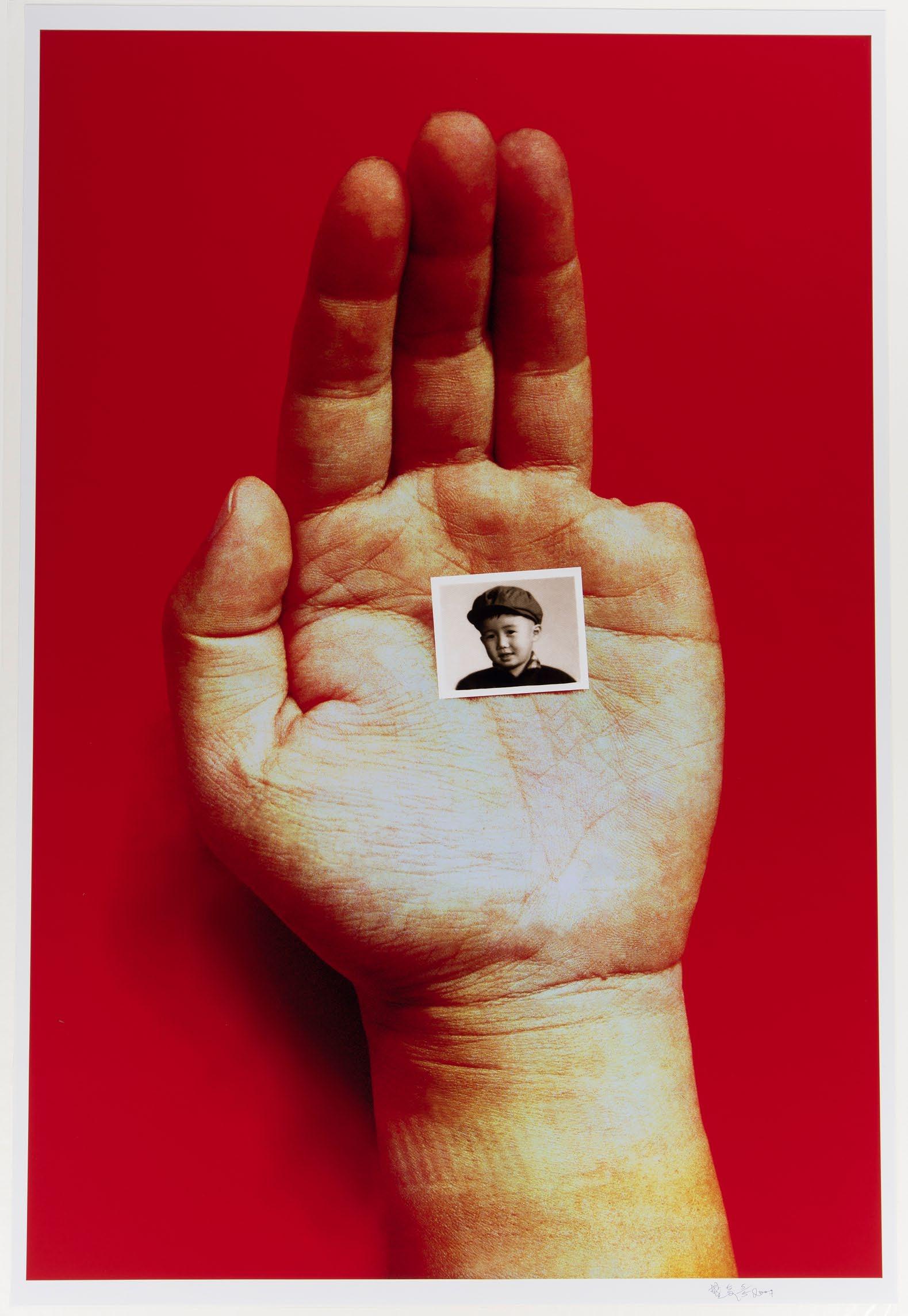
SHENG Qi 盛奇 (Chinese, born 1965)
My Left Hand - Mother 001 (我的左手 - 母亲 1 Wo de zuoshou - muqin
1), 2004
Color photograph
Gift of the Jack and Susy Wadsworth Collection of Contemporary Chinese Photographs, 2018:28.13
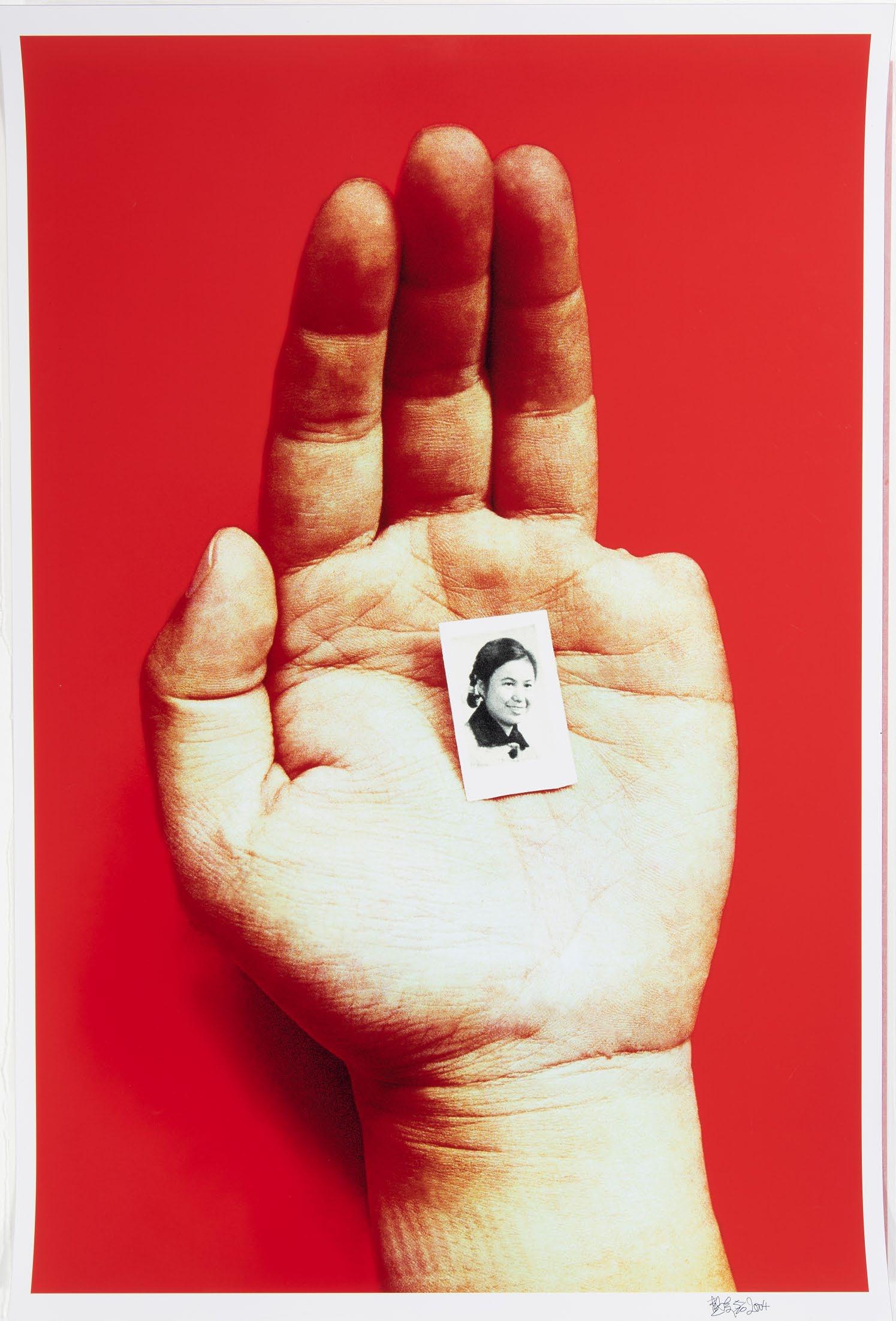
RELATED WORKS ON VIEW
(elsewhere in the JSMA)
HE Kongde 何孔德 (1925-2003)
Chinese; People’s Republic of China, 1972
Gutian Conference (古田会议 Gutian huiyi), from the series Selected Works of Art (美术作品选 Mei shu zuo pin xuan) in Commemoration of the 30th Anniversary of Mao Zedong's Talks at the Yan’an Forum on Literature and Art
Lithographic reproduction of a propaganda painting; ink and color on paper
Gift of Irwin Lavenberg, 2020:44.1.3
A contemporary photo by Shao Yinong and Muchen in the adjacent Framing the Revolution exhibition shows the hall depicted in this image.

March Towards Jinggang Mountains (

jinggangshan jinjun)
向井冈山进军
Xiang
Chinese; People’s Republic of China, 1972
Lithograph; ink and color on paper
Anonymous Gift, 2022:42.2
Chairman Mao in Northern Shaanxi (1936) The Long March, Poem by Si Nuo she (毛主席在陕北 [

] 斯诺摄 长征诗 一首 Mao Zhuxi zai Shanbei [Yijiusanliu nian] Si Nuo she changzhengshi yishou) Chinese; People’s Republic of China, n.d. Lithograph; ink and color on paper
Anonymous Gift, 2022:42.1
一九三六年
The Long March Poem
The Red Army fears not the trials of the Long March, Holding light ten thousand crags and torrents. The Five Ridges wind like gentle ripples, And the majestic Wumeng roll by globules of clay. Warm the steep cliffs lapped by the waters of Golden Sand, Cold the iron chains spanning the Dadu River.
Minshan’s thousand li of snow now joyously crossed, The three Armies march on, each face glowing.
长征诗 一首红军不 Changzheng shi yi shou 红军不怕远征难, Hongjun bupa yuanzheng nan,
万水千山只等闲。
Wangshuiqianshan zhi dengxian.
五岭逶迤腾细浪, Wuling weiyi teng xi lang, 乌蒙磅礴走泥丸。 Wumeng pang bo zou ni wan.
金沙水拍云崖暖, Jinsha shui pai yunya nuan,
大渡桥横铁索寒。 Dadu qiao heng tiesuo han.
更喜岷山千里雪, Geng xi Minshan qianli xue, 三军过后尽开颜。 Sanjun guohou jin kaiyan.
TIMELINE
1636-1912 The Qing dynasty
China’s last imperial dynasty, led by the Manchus, an ethnic group native to Manchuria.
1839-42 First Opium War
Britain objects to the Qing government’s ban of the opium trade, Britain’s most profitable commodity. China is defeated and the British impose the Treaty of Nanking, forcing the Chinese to open five coastal ports to increase foreign trade, cede Hong Kong Island, and compensate Britain for destroyed opium. The beginning of China’s “century of humiliation.”
1856-60 Second Opium War
Britain and France clash with China over the right to import opium. Foreign troops enter Beijing and loot the Summer Palace. With China’s defeat, the opium trade is legalized and the Qing government is forced to sign the Treaty of Tianjin, opening further ports and navigation channels, allowing foreign governments to establish embassies and their subjects to travel freely within China, ceding Kowloon to Britain, and paying indemnities. Land north of the Amur River and East of the Ussuri River is ceded to Russia in the Treaties of Aigun and Beijing.
1866 Birth of future statesman SUN Yat-Sen 孫中山 (1866-1925) in Cuiheng, Xiangshan, Guangdong province.
1887 Birth of future Nationalist leader CHIANG Kai-Shek 蔣介石 (1887-1975) in Xikou, Fenghua, Zhejiang province.
1893 Birth of future Communist leader MAO Zedong 毛泽东 (1893-1976) in Shaoshan, Hunan province.
1894-95 First Sino-Japanese War
Japan and China fight for political influence over Korea. China suffers humiliating losses and is forced to recognize the independence of Korea, cede the Liaoning Peninsula, Taiwan, and the Penghu Islands to Japan “in perpetuity,” and pay war reparations. For millennia, China had been the most powerful nation in Asia, and the contrast between its defeat and Japan’s rapid embrace of western-style modernization and military success is a source of shame.
1898 Birth of future Communist leader ZHOU Enlai 周恩来 (1898-1976) in Huai’an, Jiangsu province.
1899-1901 Boxer Rebellion
An unsuccessful anti-colonial, anti-Christian campaign backed by Empress Dowager Cixi 慈禧太后 (1835-1908) that sought to expel foreigners and foreign influences. Instead, it resulted in further weakening of the government and costly indemnity payments to the American, Austro-Hungarian, British, French, German, Italian, Japanese and Russian powers that sent 20,000 troops to aid the foreigners besieged for 55 days in Beijing.
1912 Establishment of the Nationalist Party (国民党 Kuomintang, or KMT).
Sun Yat-Sen takes control after 15 provinces declare independence from the Qing dynasty, establishing the Republic of China (中华民国 Zhonghua minguo) of which he becomes the first provisional president.
1915 Former Qing military commander YUAN Shikai 袁十凯 (1856-1916) attempts to reinstate monarchy with himself as emperor but abdicates and dies 83 days later.
1919 May Fourth Movement
Students gather in Beijing’s Tiananmen Square (named for the 天安門 Tiananmen, or “Gate of Heavenly Peace” that stands between the square and the main entrance at the south end of the imperial palace complex, the Forbidden City), to protest the Chinese government’s weak response to the Treaty of Versailles, which dictated that Chinese territories surrendered by Germany were ceded to Japan. Although the government arrests approximately 1,000 demonstrators, the students are bolstered by workers and businessmen who strike, threatening to paralyze the economy. Several of the young people who were active in this movement went on to espouse Communism.
1921 The Communist Party of China (中国共产党 Zhongguo
Gongchandang, officially CPC, but more commonly referred to as the Chinese Communist Party, or CCP) is founded with Soviet support.
1924 The Nationalists and Communists form an alliance (the First United Front) and create the National Revolutionary Army with the goal of unifying China.
1925 Sun Yat-sen dies and is succeeded as leader of the Nationalist Party by Chiang Kai-Shek
1927 Chang Kai-Shek orders the execution of Communists, leading the creation of the Chinese Workers' and Peasants' Red Army (中国工农红
军 Zhongguo gongnong hongjun), or Red Army. This marks the beginning of the Chinese Civil War (1927-1949).
1930 Birth of artist WANG Shilong 王世龙 in Henan province.
1931 Japanese military personnel stage a false attack to use as a pretext to justify their occupation of Manchuria, where they establish the puppet state of Manchukuo (满洲国), and install Puyi 溥儀 (1906-1967), the last Qing emperor, as the nominal regent and emperor.
1934-35 The Long March
The Long March (长征 Changzheng) is the grueling 370-day military retreat of the Red Army from Chiang Kai-Shek’s Nationalist forces. At the beginning, the Communists number approximately 70,000 as they flee from a force of 300,000 Nationalists with superior equipment. By the time the three groups of Red Army soldiers complete their 5,600-mile trek from southeast to northwest across some of China’s most difficult terrain to meet in Bao’an, Shaanxi province, one year later, their numbers had dwindled to less than 7,000. Initially commanded by various Communist leaders, over the course of the campaign power was consolidated under Mao Zedong. Despite the extreme hardship, privations and casualties suffered by the Communists during the Long March, the shared experience solidifies Mao’s leadership and contributes significantly to his cult of personality.
1936 ZHANG Xueliang 张学良 (1901-2001), a disgruntled northern warlord, kidnaps Chiang Kai-Shek and successfully negotiates a temporary ceasefire between the Nationalists and the Communists, who combine forces (creating the Second United Front) to try to expel the Japanese.
1937-45 Second Sino-Japanese War
Building on tensions that began during the First Sino-Japanese War and exacerbated by Japan’s 1931 invasion of Manchuria, fighting breaks out between Japanese and Chinese troops on Beijing’s Marco Polo Bridge in 1937 and escalates to full-scale Japanese attacks on Beijing, Tianjin, Shanghai, Nanjing, and Wuhan, with horrific casualties. Chiang Kai-Shek attempts to prevent further Japanese advances by opening dikes on the Yellow River, but the resulting floods destroy thousands of square miles of villages, agriculture, and property, kill 400,000 people, and displace several million more.
1940-41 Although they are supposed to collaborate to beat the Japanese, there are frequent clashes between Nationalist and Communist forces. In 1941, Nationalist troops suddenly turn and ambush a Communist unit, effectively ending the alliance.
1945 After the Japanese surrender in World War II, Taiwan is returned to China.
1947 Establishment of the People’s Liberation Army (
Zhongguo renmín jiefangjun, or PLA).
中国人民解放军
1949 Mao Zedong proclaims the Communist Party’s establishment of the People’s Republic of China (
Zhonghua renmin gongheguo) from atop the Tiananmen gate of the Forbidden City during a ceremony and military parade.
Chiang Kai-Shek retreats to Taiwan with 2,000,000 soldiers and their families and establishes a provisional government claiming to be the legitimate ruler of China.
1951 Birth of artist Liu Heung Shing 劉香成 in Hong Kong, then under British rule.
1960s Insurmountable doctrinal differences result in the Sino-Soviet split, shelving the Sino-Soviet Treaty of Friendship of 1950. All Soviet political advisers and engineers are recalled from China.
中华人民共和国
1958-61 The so-called Great Leap Forward (大跃进 Da yue jin) is Mao Zedong’s campaign to rapidly transform China from an agrarian economy to a communist society through the establishment of people’s communes. Unfortunately, unrealistic agricultural production goals and crude attempts to smelt steel in the countryside, plus the desire to repay Soviet debts and provide free grain to other nations are all contributing factors leading to China’s Great Famine (三年大饥荒 San nian da jihuang), in which tens of millions die. As a result of this failed campaign, Mao steps down as President, but still maintains his position as Chairman of the Communist Party.
Photos such as those by Wang Shilong represent the upbeat messaging that Mao’s propaganda machine wants to disseminate.
1961 Birth of artist SHAO Yinong 邵逸农 in Xining, Qinghai province.
1965 Birth of artist SHENG Qi 盛奇 in Hefei, Anhui province.
1966 Birth of artist XIAO Lu 肖鲁 in Hangzhou, Zhejiang province.
1966-76 Mao Zedong initiates the Great Proletarian Cultural Revolution (无产阶级文化大革命, Wuchan jieji wenhua da geming) in 1966 to consolidate his political power by urging young people to rid China of its remaining traditional/capitalist elements to preserve Communism. The youth respond by organizing political units called Red Guards (红卫兵 Hong weibing), which Mao encourages to engage in political purges and destroy the “Four Olds” (old customs, culture, habits, and ideas). Schools and colleges are closed and people study “Mao Zedong Thought” or “Maoism” (毛泽东思想, Mao Zedong sixiang) by carefully reading the so-called “Little Red Book” of Chairman Mao (Quotations from Chairman Mao Zedong 毛主席语录 Mao zhuxi yulu, first published in 1964). After violent struggles break out between rival youth groups, Mao enlists the People’s Liberation Army to quell the upheaval and sends millions of students to the countryside to be reeducated by peasants. Despite his potent personality cult, Mao’s actual political power diminishes over the course of the Cultural Revolution, supplanted by four high-ranking officials – JIANG Qing 江青 (1914-1991, Mao’s last wife), ZHANG Chunqiao
张春桥 (1917-2005), YAO Wenyuan 姚文元 (1931-2005), and WANG
Hongwen 王洪文 (1935-1991), who were later dubbed the “Gang of Four” (
四人帮 Si ren bang). The Cultural Revolution results in a still unknown number of deaths (estimated between hundreds of thousands to millions) and the virtual deification of Mao Zedong
1970 Birth of artist MUCHEN 沐辰 in Dandong, Liaoning province.
1971 Birth of artist QIN Ga 琴嘎 in Bayannur, Inner Mongolia.
1972 U.S. President Richard Nixon (1913-1994) visits China.
1975 Death of Nationalist leader Chiang Kai-Shek in Taiwan.
1976
January Death of Premier Zhou Enlai in Beijing. The eulogy delivered by Vice-Premier DENG Xiaoping 邓小平 (1904-1997) extolling Zhou’s virtues is interpreted as criticism of Mao Zedong and other political leaders of the Cultural Revolution. Deng is persecuted and Zhou’s political enemies prohibit any further displays of mourning and mount a posthumous smear campaign, which only strengthens the public’s attachment to Zhou’s memory.
April April Tiananmen Incident
The April Tiananmen Incident (四五天安门事件 Siwu Tiananmen shijian) on April 4, the eve of the Qingming festival, when families traditionally honor their ancestors, sees approximately two million people spontaneously gather in Tiananmen Square to mourn Zhou Enlai by placing wreaths, poems, and flowers at the foot of the Monument to the People’s Heroes (人民英雄纪念
碑 Renmin Yingxiong Jinianbei). They also denounce the Gang of Four, Chairman Mao, and the Cultural Revolution. The next morning, the crowds that assemble beside the monument become agitated when they discover that the makeshift memorial had been removed overnight. Attempts to suppress the mourners lead to a violent riot and hundreds of arrests. Similar incidents occur in several other cities. Deng Xiaoping is stripped of all official positions.
September Death of Chairman Mao Zedong in Beijing.
October Under the orders of Acting Premier HUA Guofeng 华国锋 (1921-2008) the Gang of Four is arrested and tried (in 1981) for attempting to usurp power and for persecuting more than 700,000 people during the Cultural Revolution, at least 34,375 of whom were killed.
December Deng Xiaoping becomes leader of the People’s Republic of China
1978 Reform Era
A brief period of political liberalization ensues in which people have greater freedom to criticize the government by, for example, posting comments and grievances on the Democracy Wall (民主墙 Minzhu qiang) on Xidan Street in Beijing’s Xicheng District.
1979 Stars Art Exhibition
The Stars Art Group (星星画会 Xingxing huahui), a collective of non-professional avant-garde artists, is formed by MA Desheng 馬德升 (born 1953) and HUANG Rui 黄锐 (born 1952) and includes AH Cheng 钟阿城 (born 1949), AI Weiwei 艾未未 (born 1957), LI Shuang 李爽 (born 1957), QU Leilei 曲磊磊, (born 1951), and WANG Keping 王克平 (born 1949). These young artists come together because of shared interests in individualism, freedom of expression, and abstract Western art (as opposed to the Soviet-style Socialist Realist art characteristic of the previous decades). In November 1979 they mount the first Stars Art Exhibition (星星美展 Xingxing meizhan), for which they secure no approval, but instead install their art in Beihai Park along the fence surrounding Beijing’s China Art Gallery. When the authorities shut down their unsanctioned display, the Stars artists stage a protest with speeches and a parade that succeeds in persuading the officials to allow them to reopen the show, which was attended by approximately 200,000 visitors in less than two weeks. Liu Heung Shing’s evocative journalistic photos of their activities effectively capture the artists’ infectious optimism and creativity. The Stars organized another exhibition in 1980 but were forced to disband due to political pressures such as the Anti-Spiritual Pollution Campaign (清除精神污染 Qingchu jingshen wuran) that impelled various members to go into self-imposed exile in Europe and the United States starting around 1983.
February China Avant-Garde Exhibition
China’s first official avant-garde art exhibition, which includes approximately 300 experimental works by 186 artists, is mounted in the National Art Museum of China (formerly the National Art Gallery) in Beijing. The show’s symbol is derived from the “No U Turn” traffic sign, implying that there can be no turning back. The February 5 opening is chaotic, with a variety of strange, unauthorized performance pieces including one in which LI Shan 李山 (born 1942) washes his feet, another in which WU Shanzhuan 吳山專 (born 1960) sells frozen shrimp, a third in which WANG Deren 王德仁 shouts and throws condoms, and finally a fourth in which ZHANG Nian 张念 (1964-2016), who was not a featured artist, sits “hatching” eggs. The exhibition closes abruptly only a few hours later after the artist XIAO Lu fires two gunshots into her own art installation (see photo and further explanation at the other end of this gallery). Riot police arrive quickly, shut the museum, and take her into custody. The exhibition is allowed to reopen but must close again due to a bomb threat. Ultimately, China Avant-Garde is on view for only 8 of its intended 15-day run and many of the organizers and sponsors are fined by the authorities. However, domestic and international media revel in the news of this unorthodox artistic event that became a political/cultural sensation.
April The death of pro-reform politician HU Yaobang 胡耀邦 (1915-1989) inspires students to protest in Tiananmen Square. When their demand for direct talks with Communist Party leadership is rebuffed, they boycott class attendance. Riots break out in other cities. The government brands the protests as an attempt to overthrow the political system. Leaders publish an editorial intended to frighten the protestors, to no avail. Bolstered by support from the workers, 50,000-100,000 demonstrators march to Tiananmen and break through police lines. General Secretary ZHAO
Ziyang 赵紫阳 (1919-2005) meets with the protest leaders and makes modest concessions, without full government support.
May Just days before a visit by Soviet leader Mikhail Gorbachev (1931-2022), the students stage a hunger strike. Their action garners support from the general population, with approximately 1,000,000 demonstrating in solidarity. Foreign reporters intending to cover the Gorbachev visit stay in Beijing to cover the movement. Students from other parts of the country and Hong Kong arrive in Beijing as protests continue in hundreds of other cities.
1989
Frustrated by the erosion of government authority due to the widespread sympathy for the protesters, Deng Xiaoping threatens to declare martial law.
Zhao Ziyang pleads with the students to return to their classes and not to sacrifice themselves. Deng removes Zhao from office as the government gathers evidence to identify and punish the demonstrators. 250,000 troops mobilize in Beijing as division intensifies among the protestors.
June A report that labels the students as terrorists and counterrevolutionaries circulates among party leaders. The army’s initial approach toward Tiananmen is prevented by roadblocks, and unarmed troops and plainclothes soldiers’ attempt to smuggle weapons into Beijing are rebuffed. On June 3, people again take to the streets despite loudspeaker warnings to stay indoors because martial law will be enforced. Military tanks and personnel carriers that arrived after midnight first fire into the air. When they encounter substantial blockades, they begin shooting at demonstrators, inflicting significant casualties. Outraged residents attack the military with sticks, rocks, and home-made explosives, set fire to their vehicles, and beat the soldiers. Helicopters appear above the square as students meet beside a 30-foot statue of the Goddess of Democracy (自由女神 ziyou nushen) they created with metal, foam, and papier-mâché and positioned as if in opposition to the monumental image of Mao Zedong that hangs above the main entrance to the Forbidden City. Ultimately, the protesters on the square are surrounded and entreat the soldiers to refrain from using force. Some persuade the military to allow them to evacuate. Nevertheless, a number are wounded as they attempt to leave. Later in the morning of June 5, thousands of civilians try to enter Tiananmen Square but the troops open fire. The crowd tries several more times, each resulting in gunfire that wounds and kills an unconfirmed number of victims. Smaller protests take place in other cities. The authorities vilify the students, attracting worldwide condemnation. As a result, embargoes are imposed on China and human rights organizations condemn the government, while China’s leaders control press coverage and strengthen surveillance, halting the liberalization of the late 1970s-80s. The government sets limits on political expression that have remained in place. Commemorating the 1989 Tiananmen student pro-democracy protests is equated with questioning the legitimacy of the Chinese Communist Party and remains one of the nation’s most sensitive and widely censored topics. Artists such as Sheng Qi develop a deeply personal language to express the sense of betrayal and grief felt by a generation whose beliefs were shaken to the core by these events.
1997 Hong Kong returns to China after 158 years of British rule.
1999 Macao returns to China after 400 years of Portuguese rule.
2002-ongoing The Long March Project (长征计划 Changzheng jihua) is an ongoing curatorial and artistic practice initiated by Beijing-based curator and project founder LU Jie 卢杰 (born 1964) and artist QIU Zhijie 邱志杰 (born 1969). Their collective begins in 2002 with the “ Long March Project A Walking Visual Display,” which introduces the 1934-35 Long March as a guiding metaphor, retracing the Red Army’s progress along the historic route and producing or participating in performances and displays at twelve sites along the way. The project framework demonstrates the ways in which revolutionary thought continues to affect Chinese visual culture and explores how local memories can be mobilized to reinterpret historical consciousness. The multifaceted practice of the Long March Project includes collective walks, discussions, writings, and visual displays with discursive lines of inquiry into a range of projects both in China and abroad. Many of the works by Qin Ga and collaborators Shao Yinong and Muchen were created during the first year of The Long March Project Qin (who stayed in Beijing) participated by transcribing the progress of the marchers on a map of China tattooed on his back, and Shao Yinong and Muchen by traveling with the group and documenting assembly halls that were sites of historic meetings. Because the collective was only able to complete the first part of the Red Army’s journey in 2002, Qin Ga decided to complete his Miniature Long March on his own three years later.
2008 Beijing hosts the XXIX Summer Olympics.
Images © the Artists
Text © Jordan Schnitzer Museum of Art, University of Oregon, 2023.
All rights reserved.
No portion of this publication may be reproduced without the written permission of the publisher.



































































